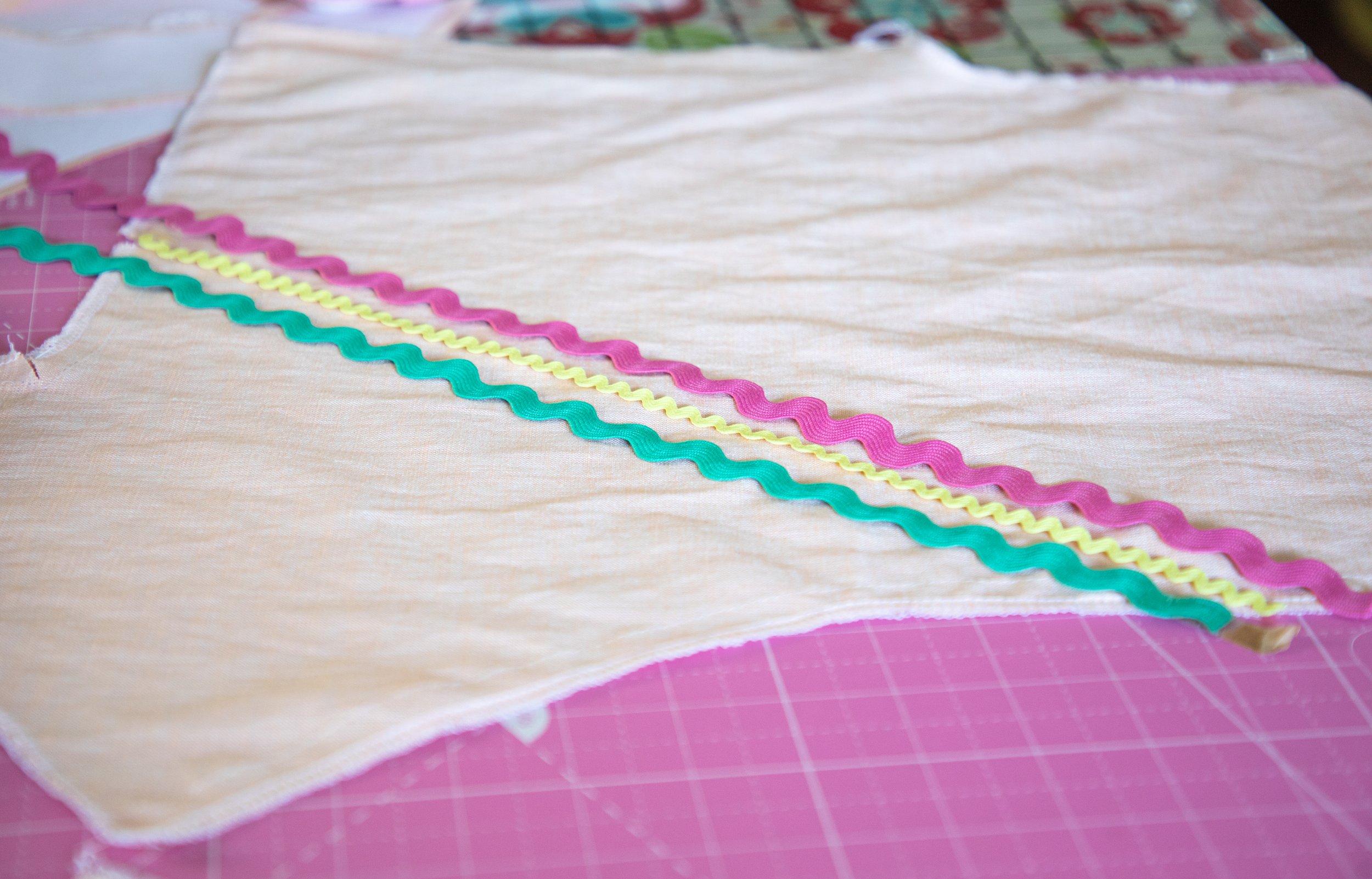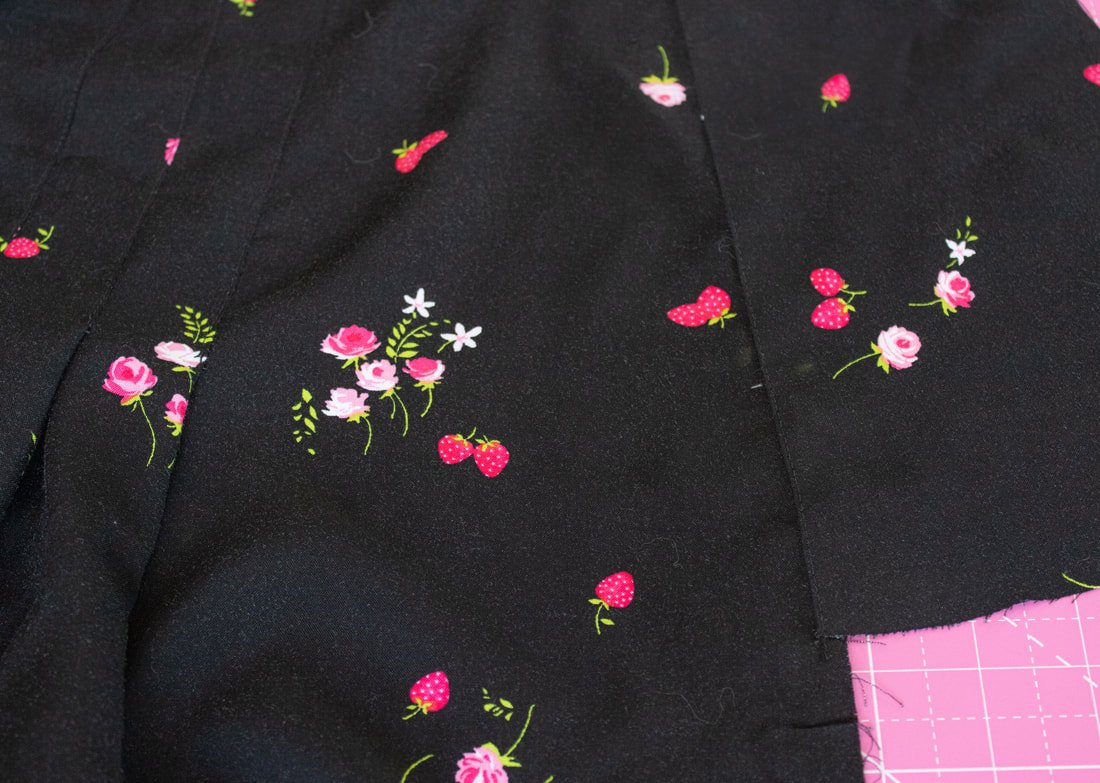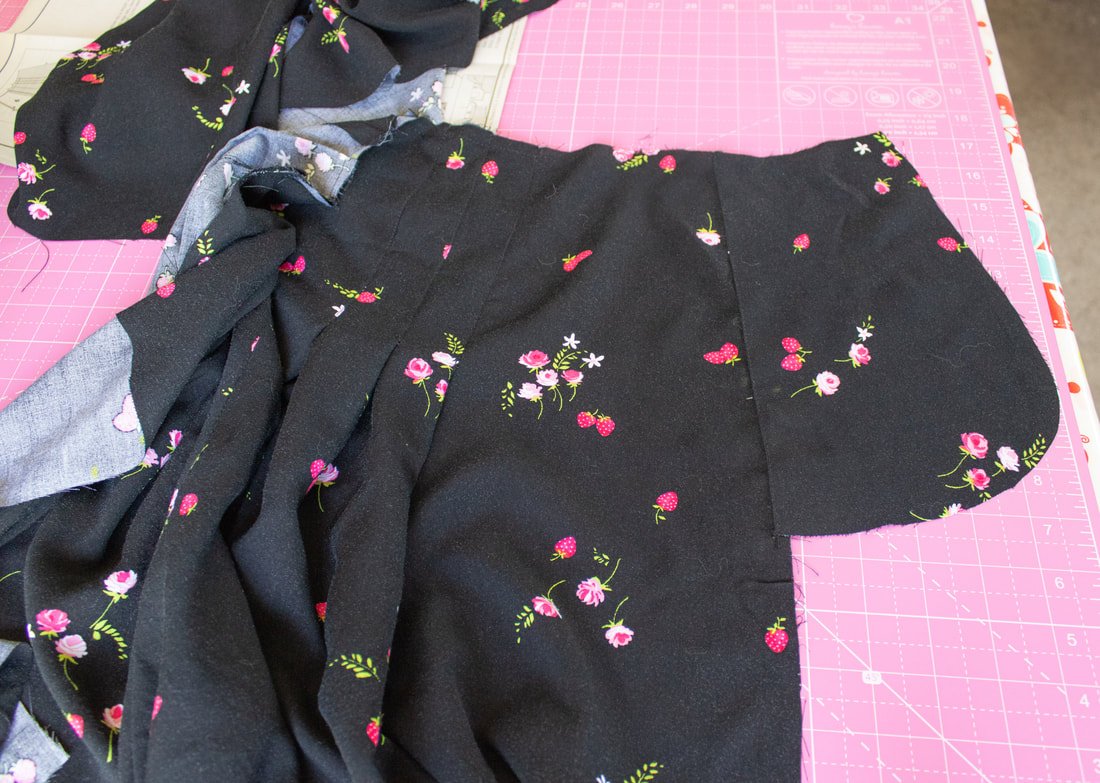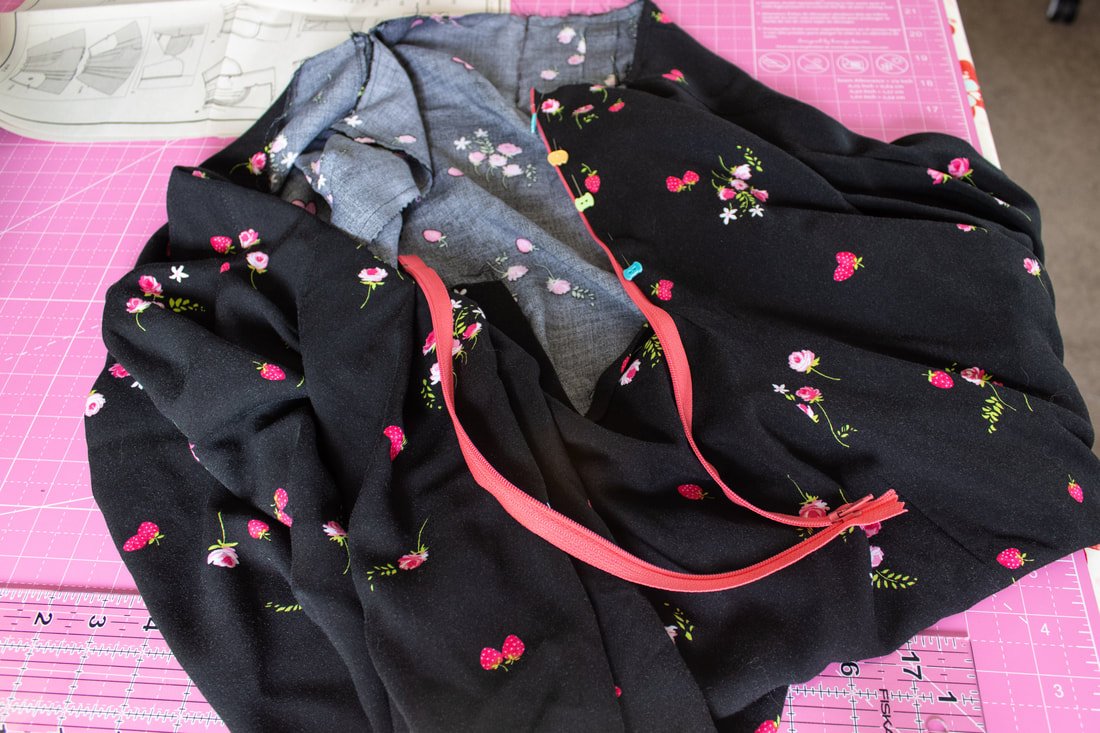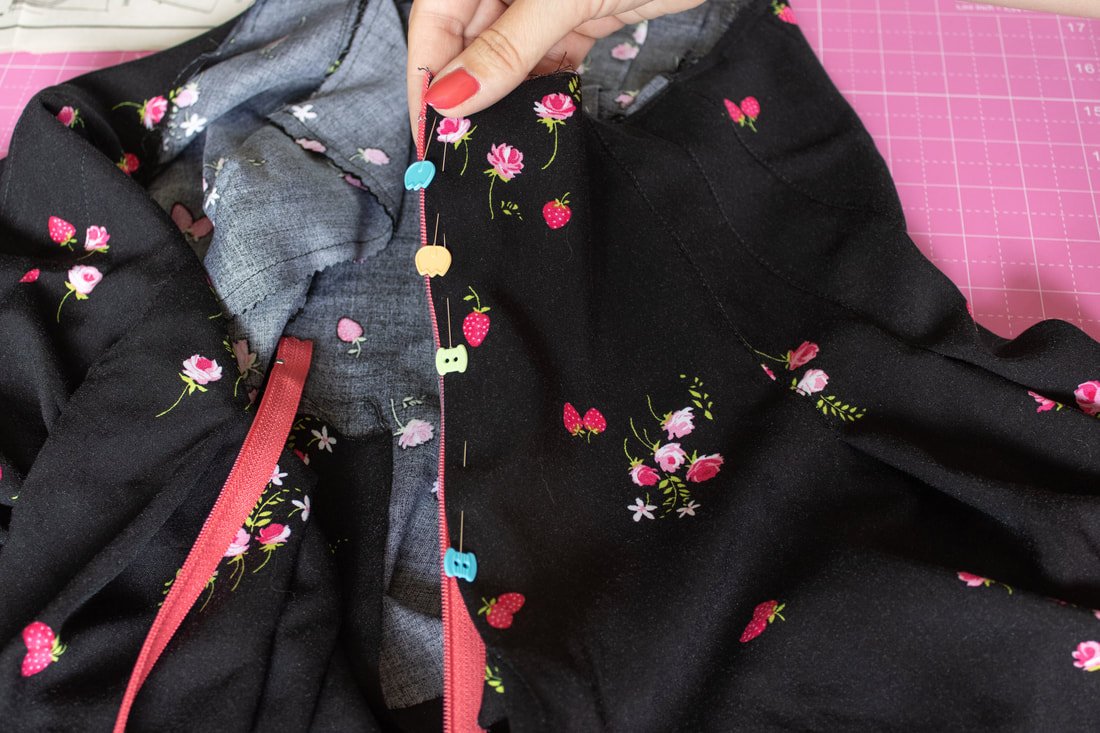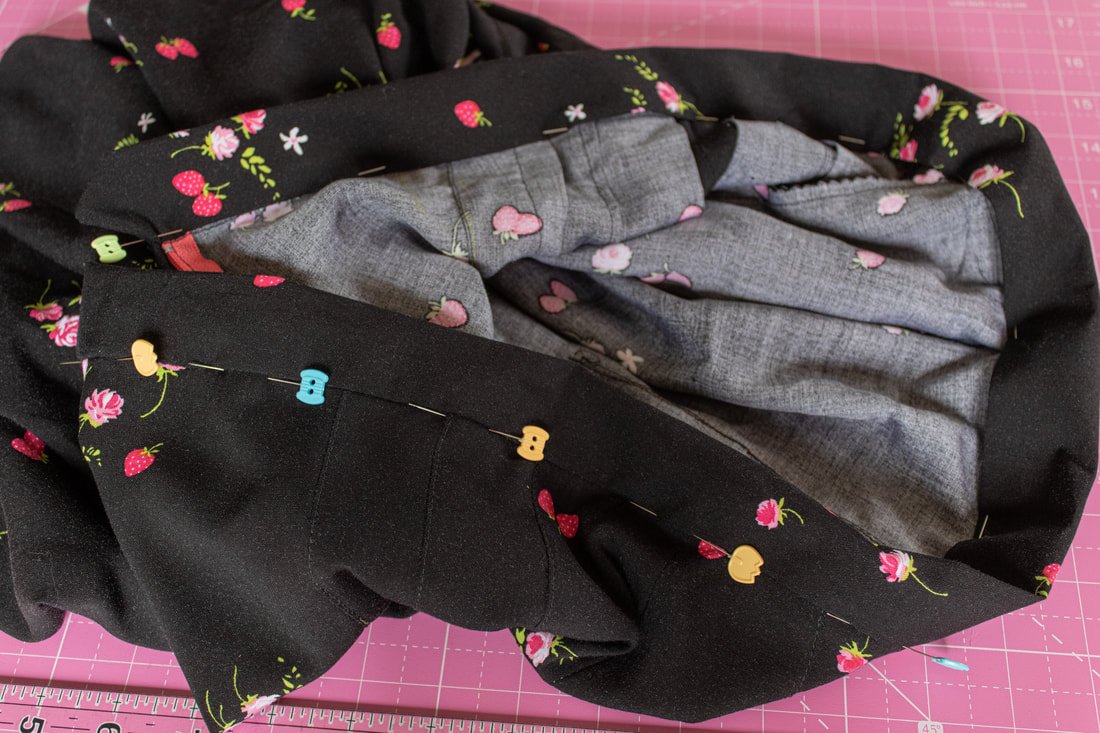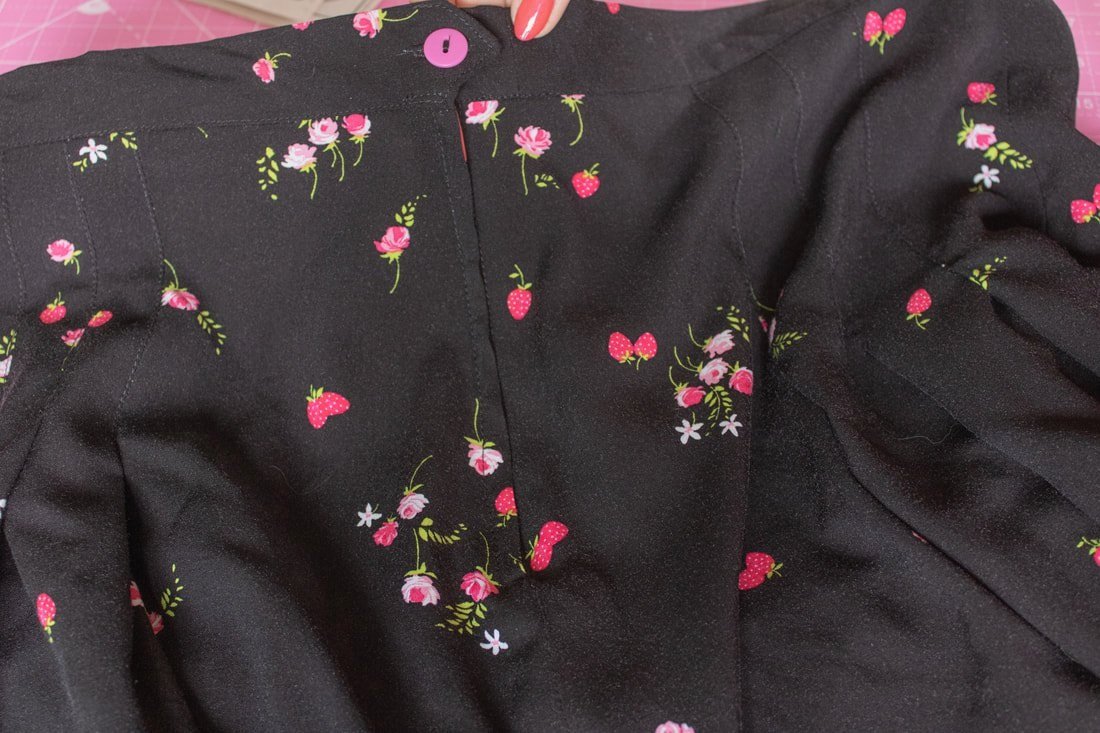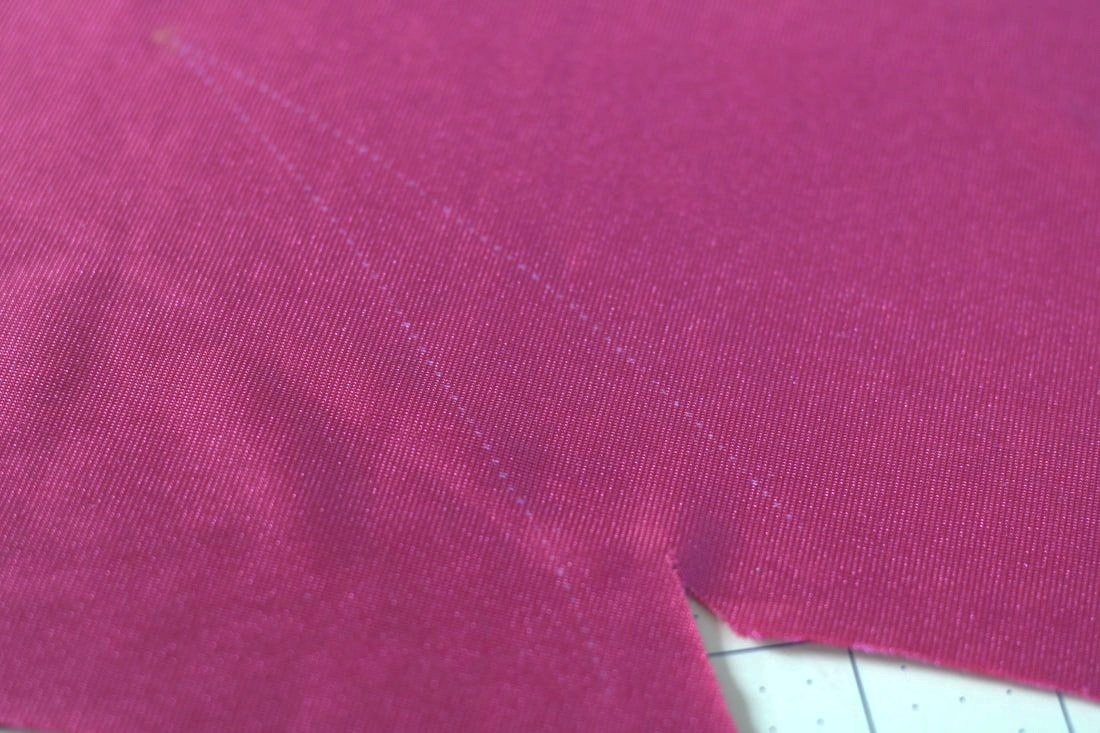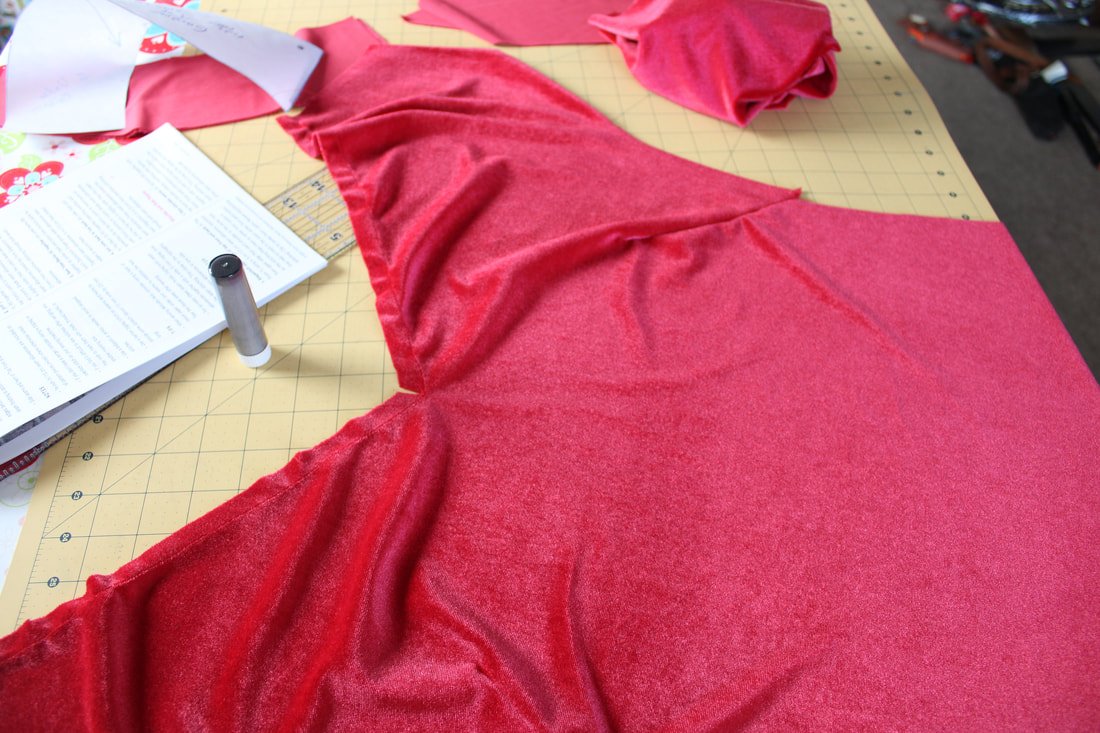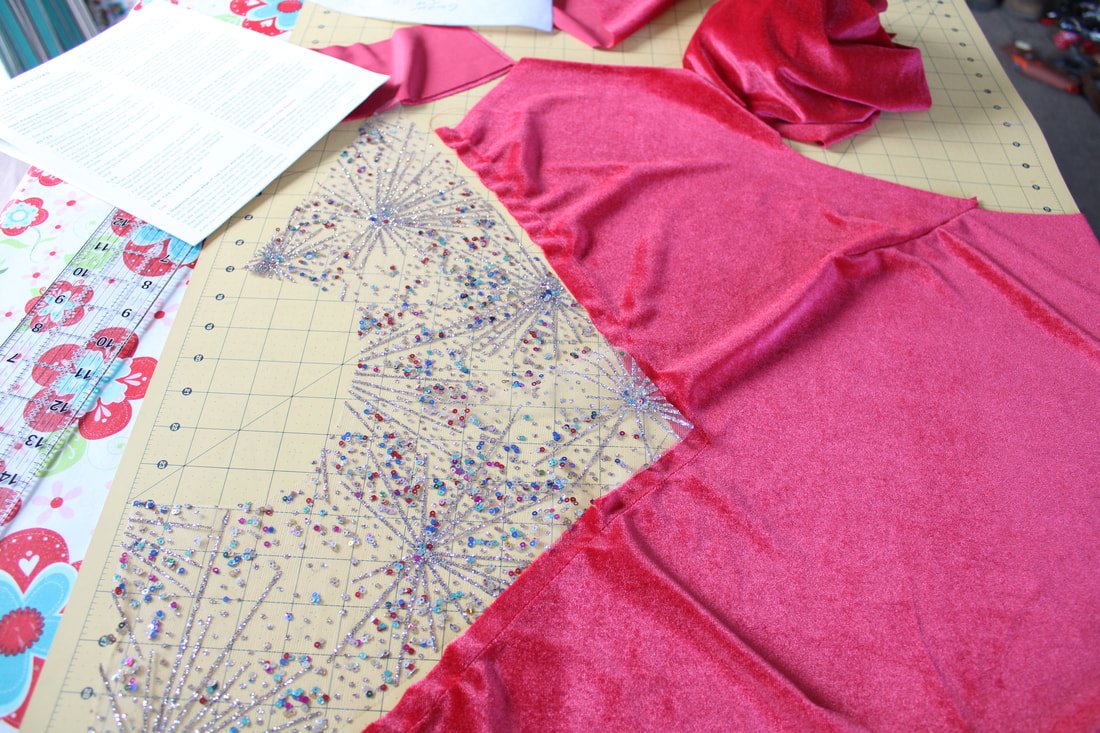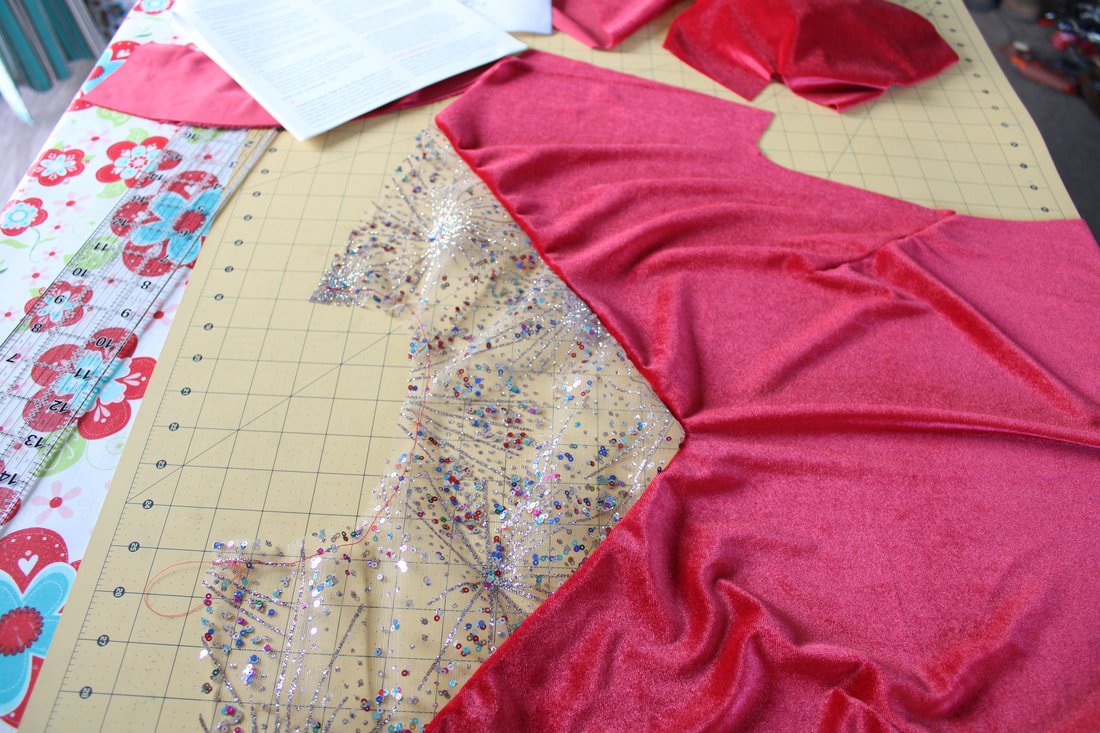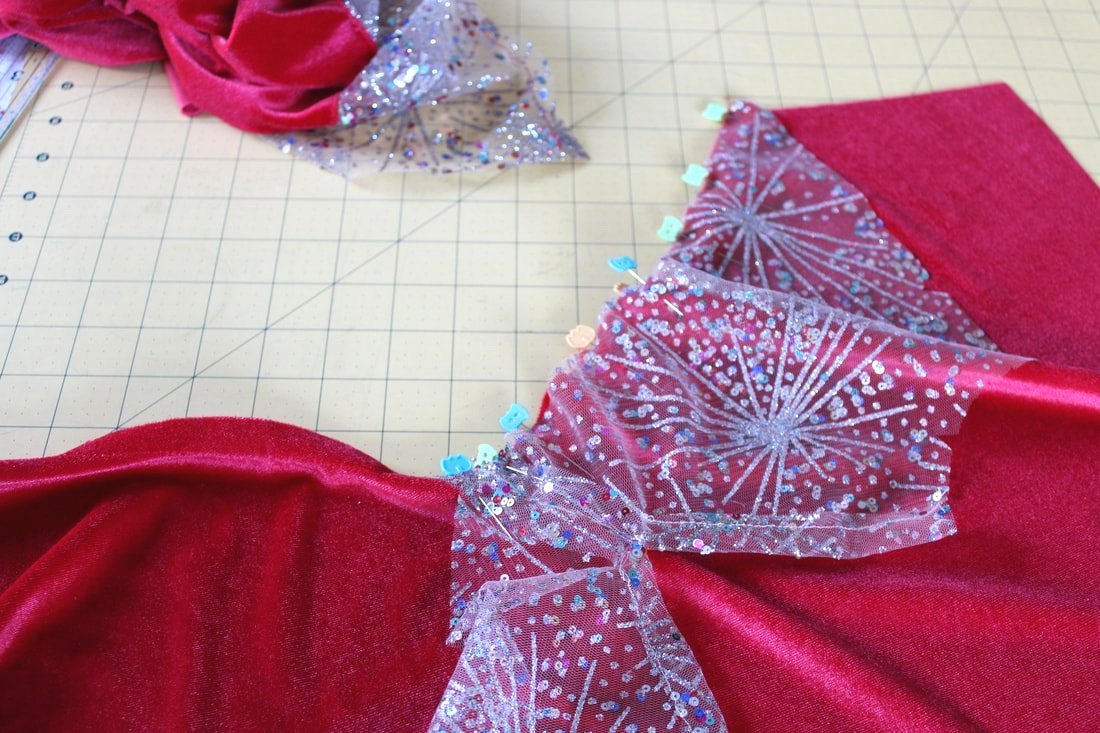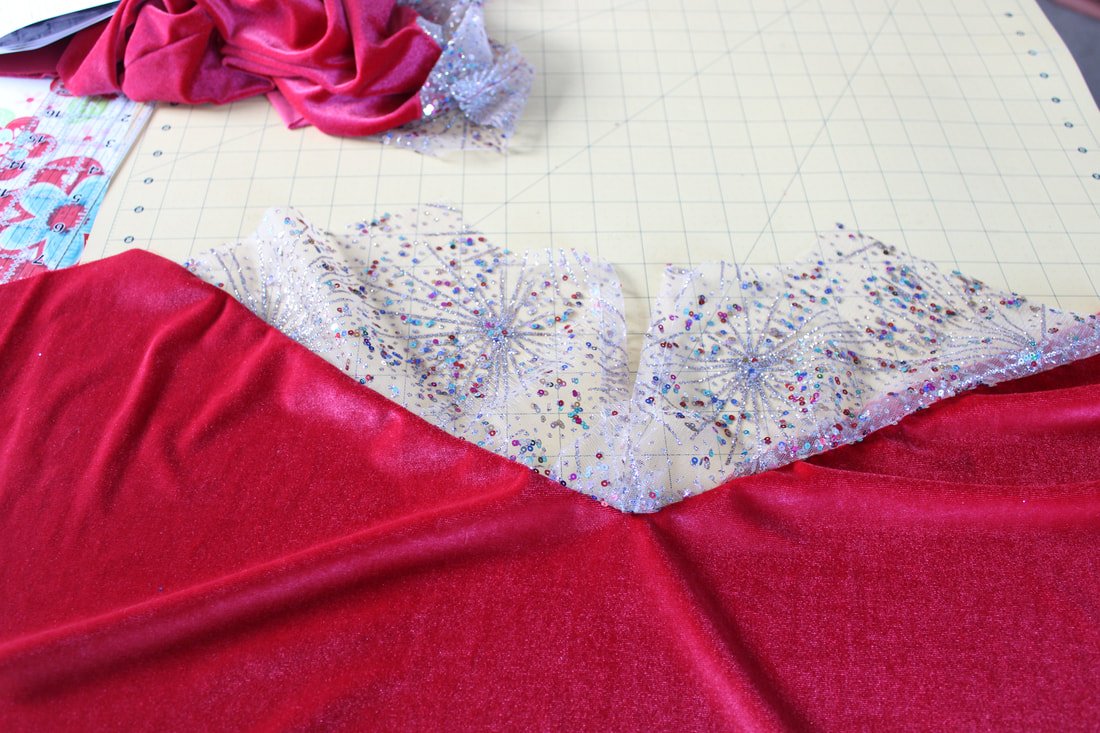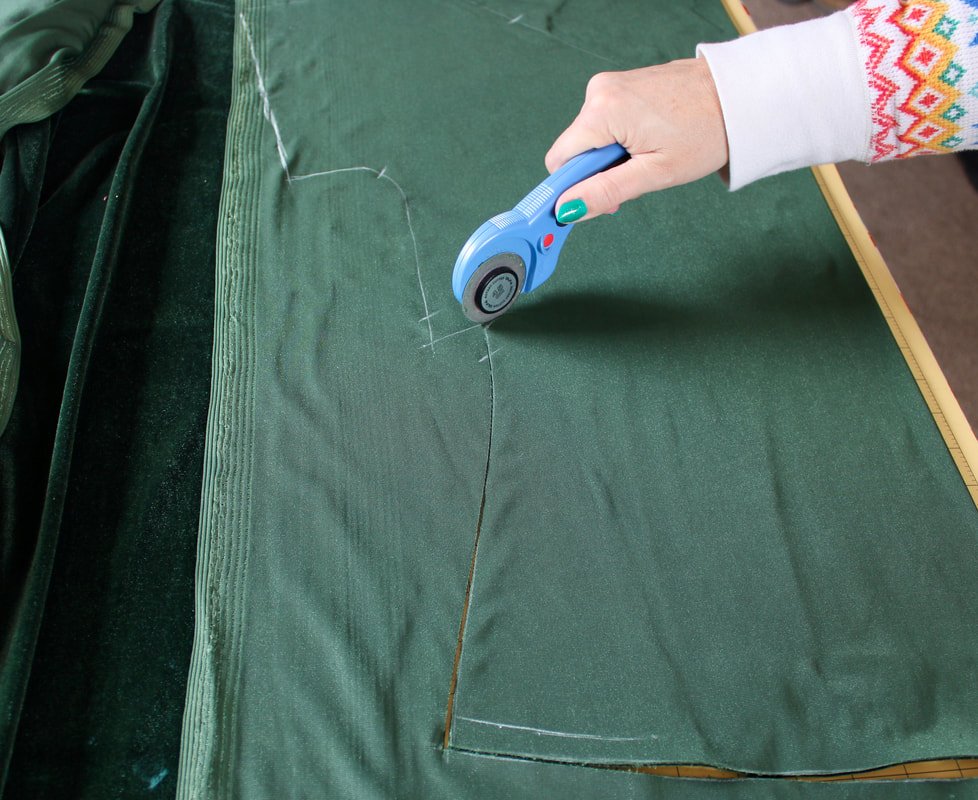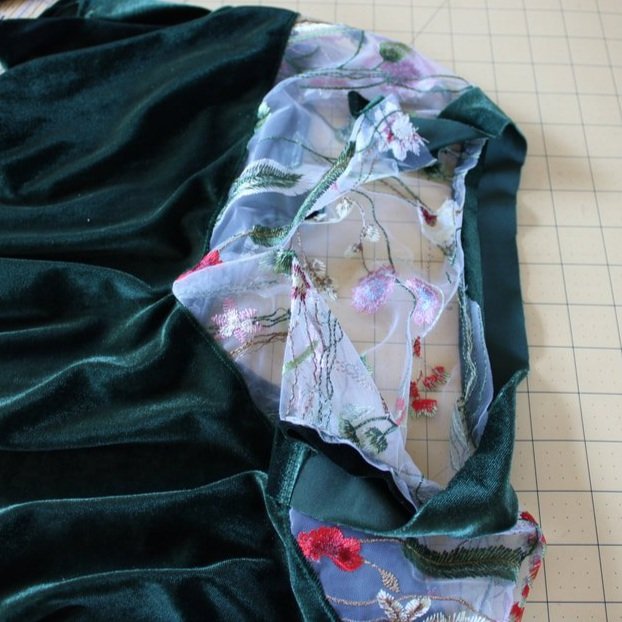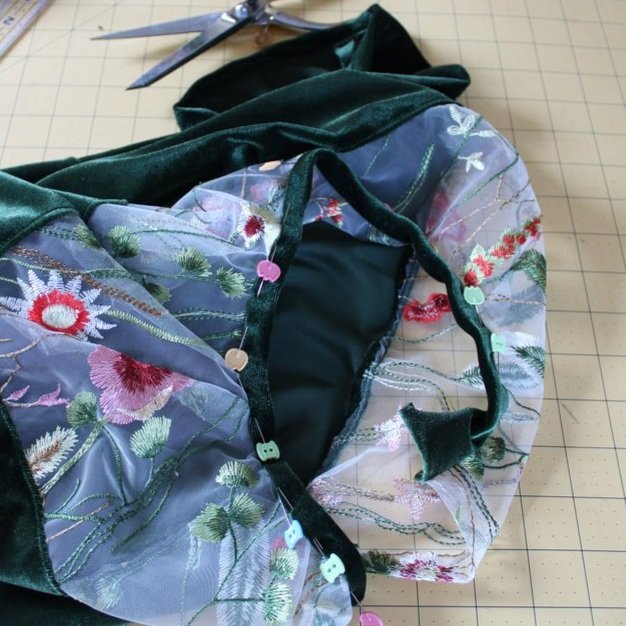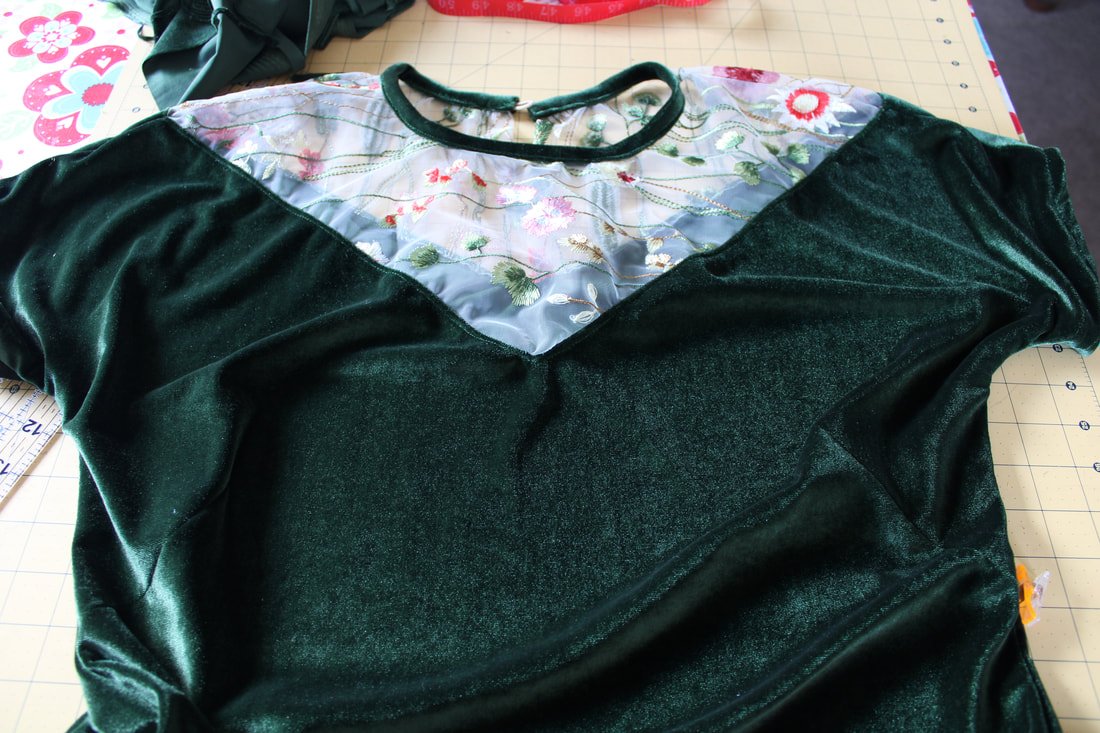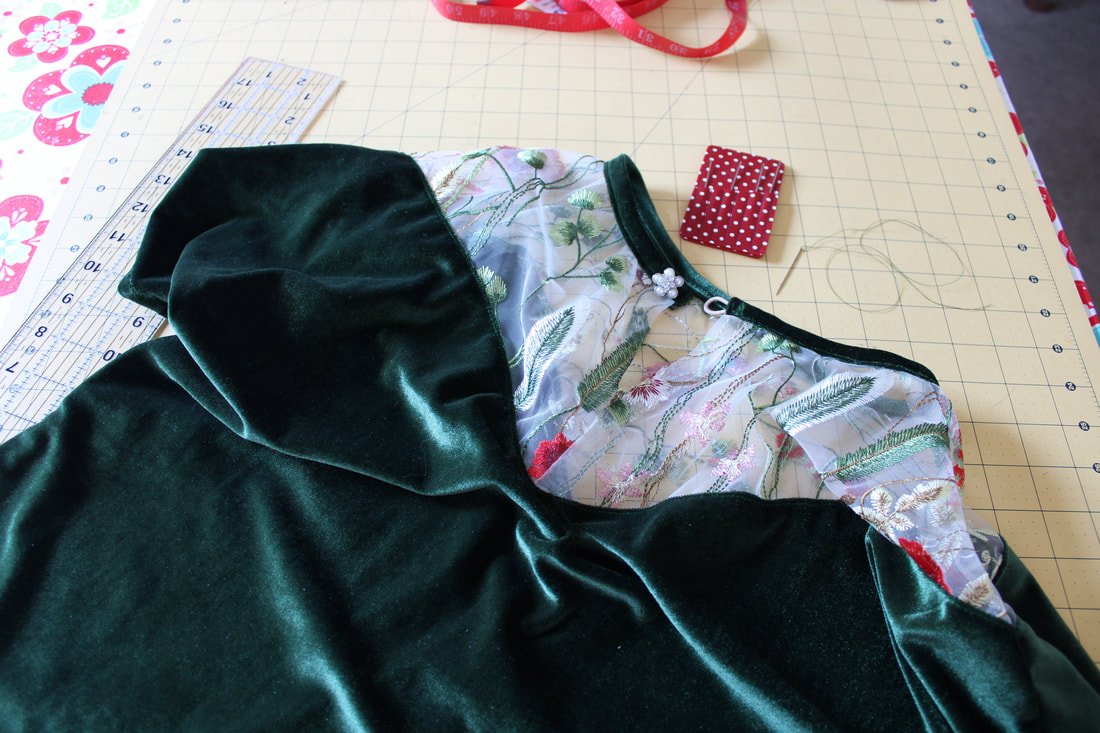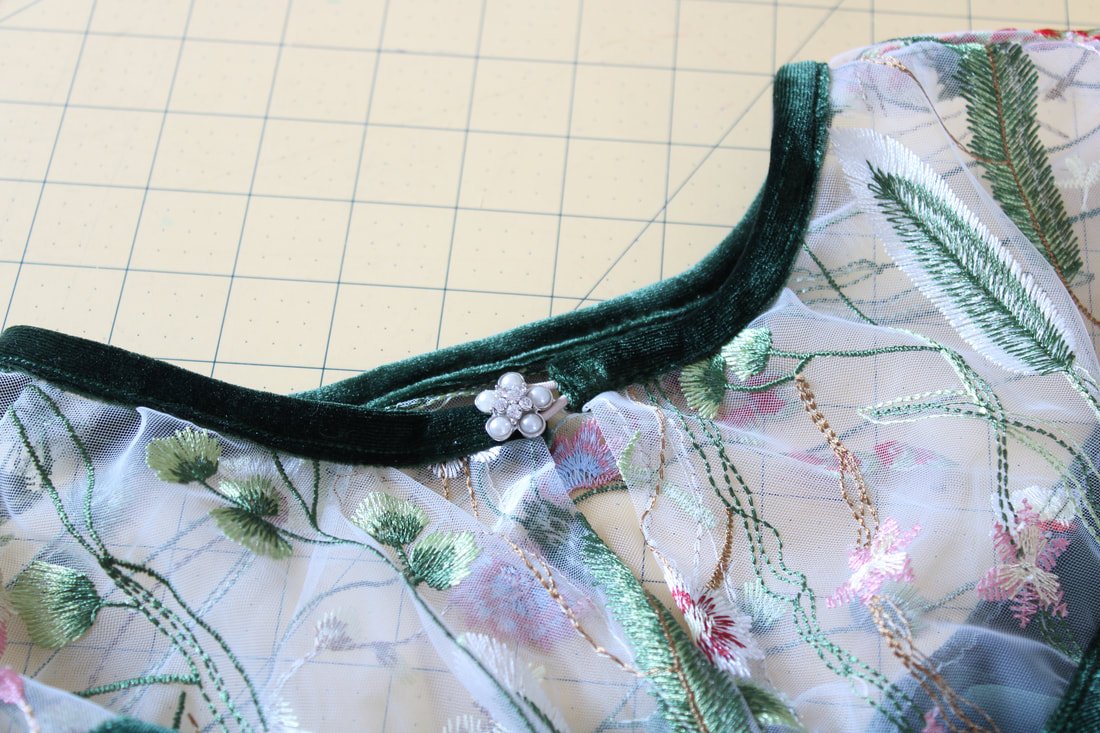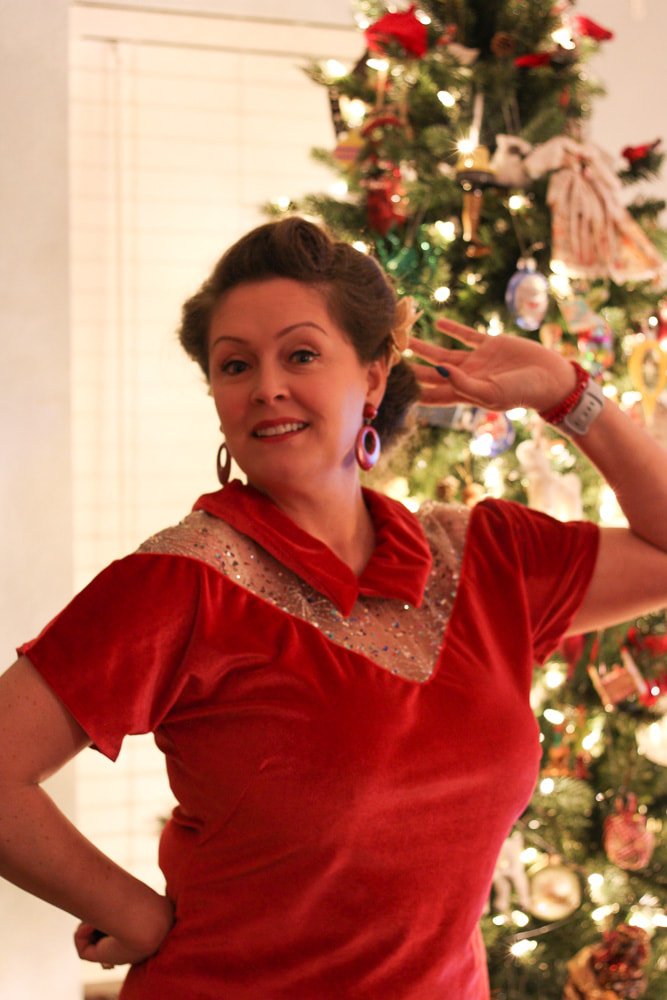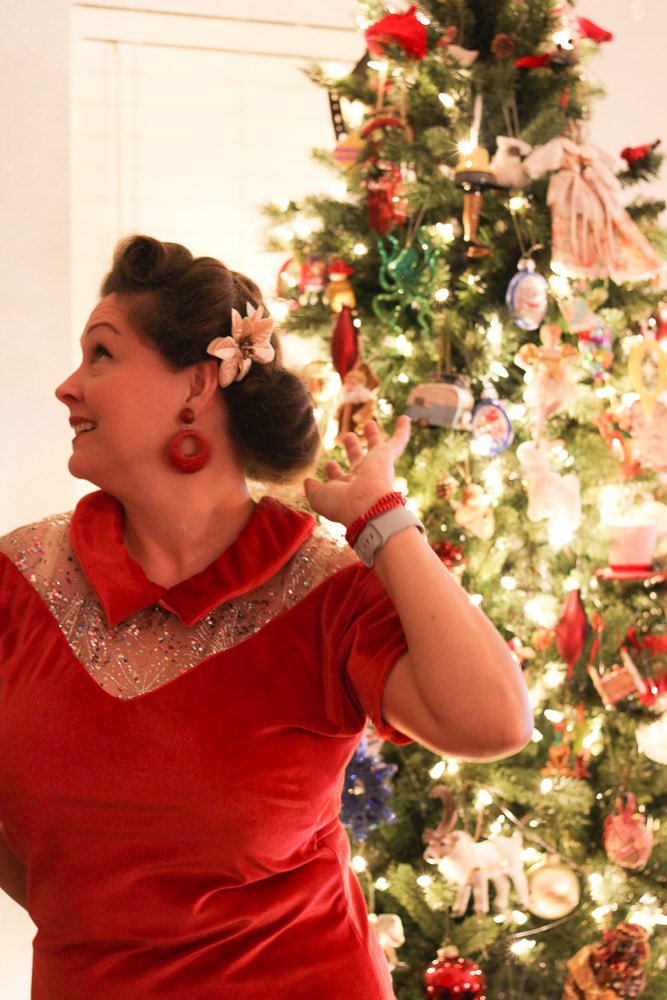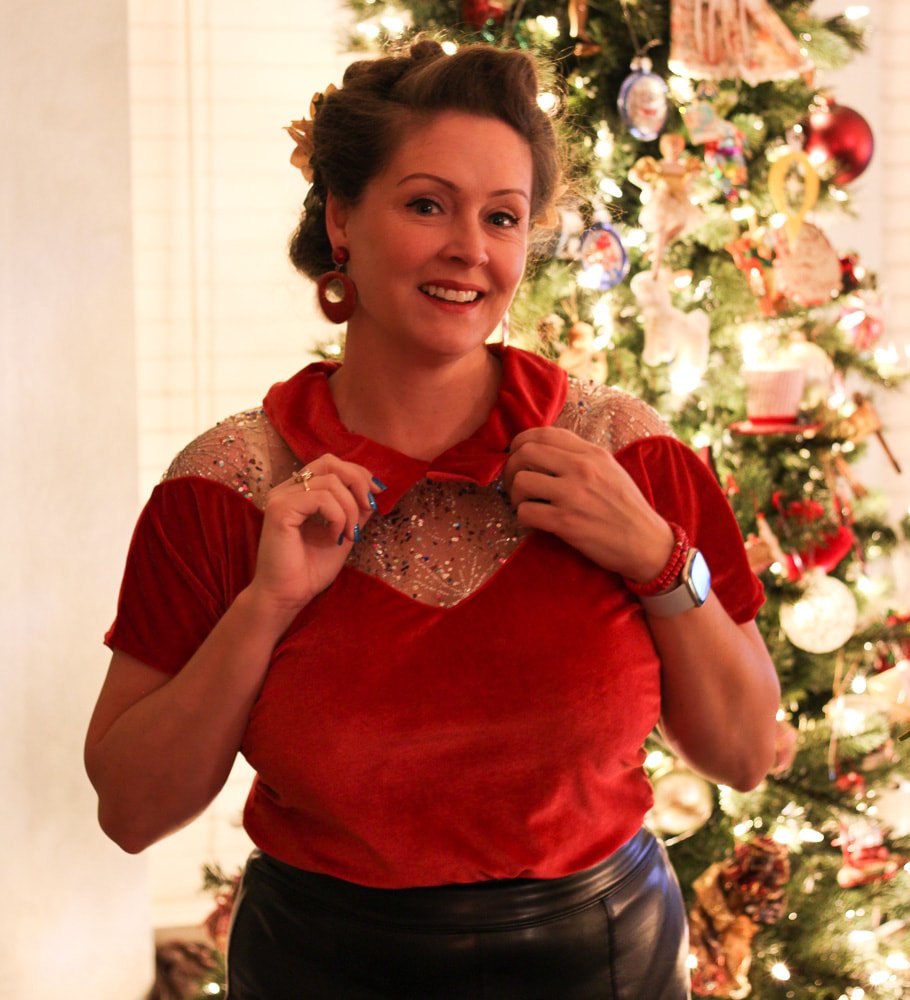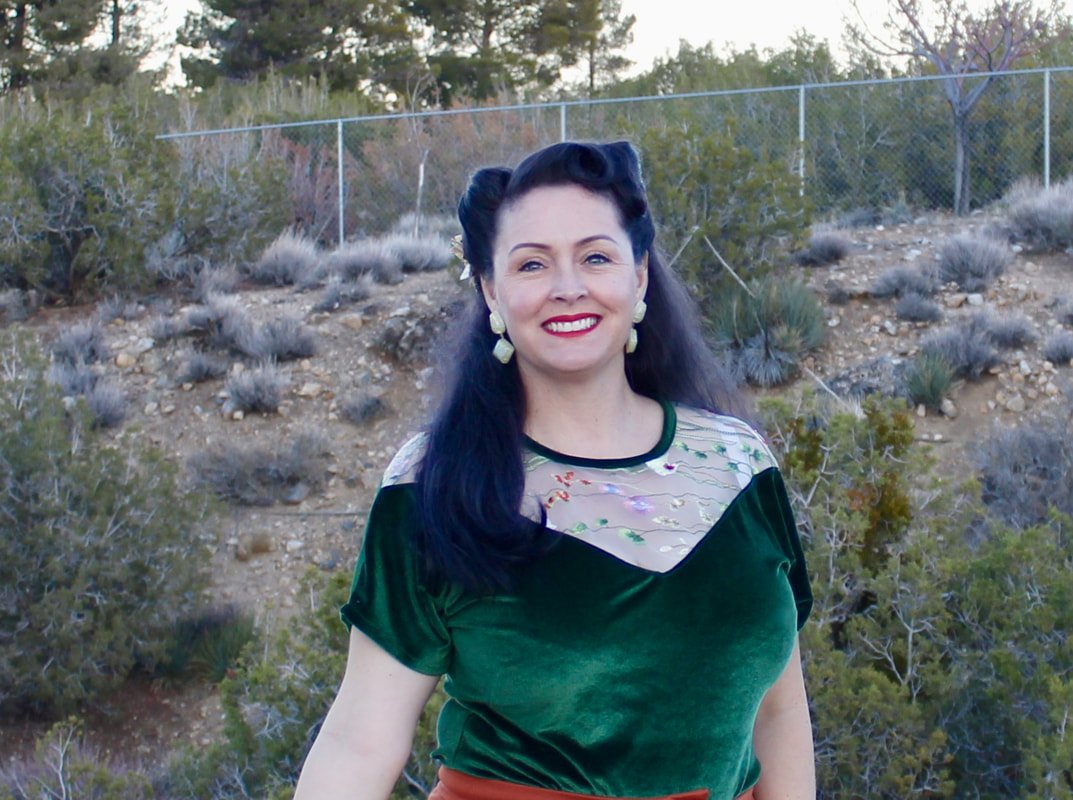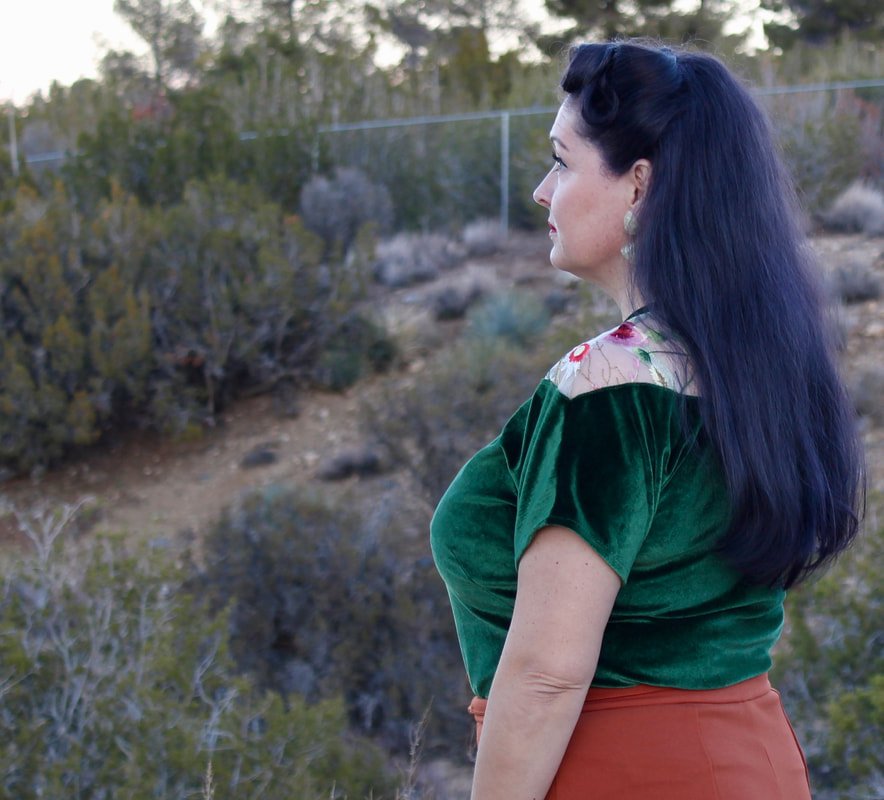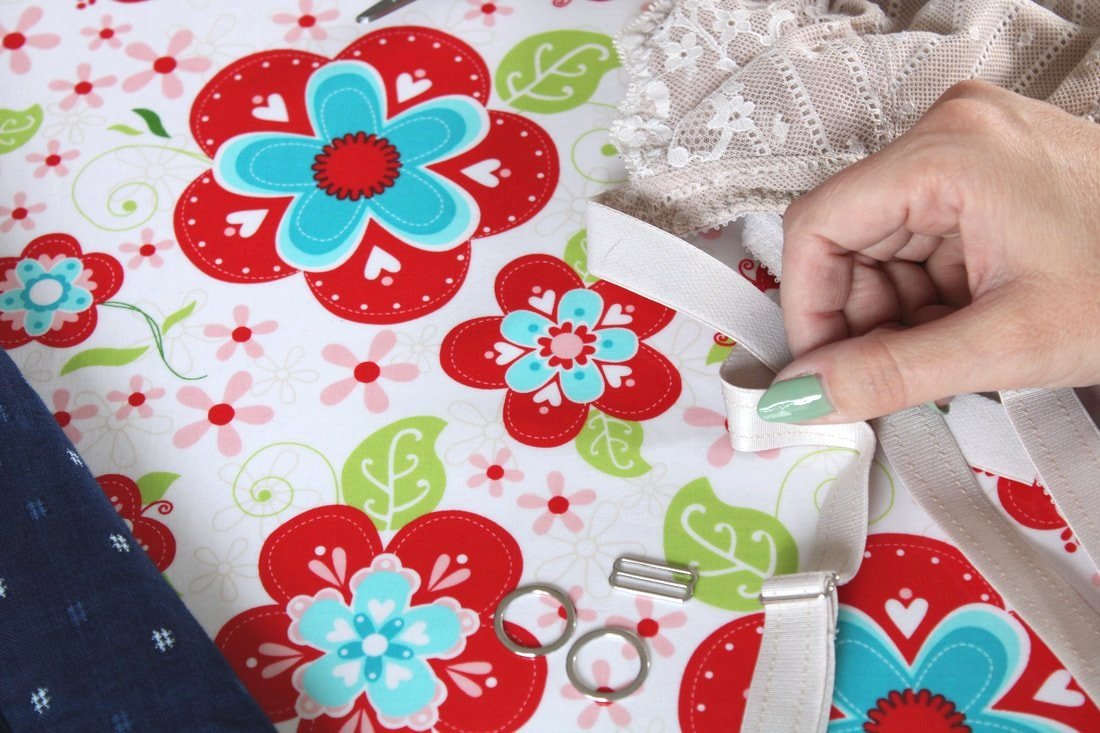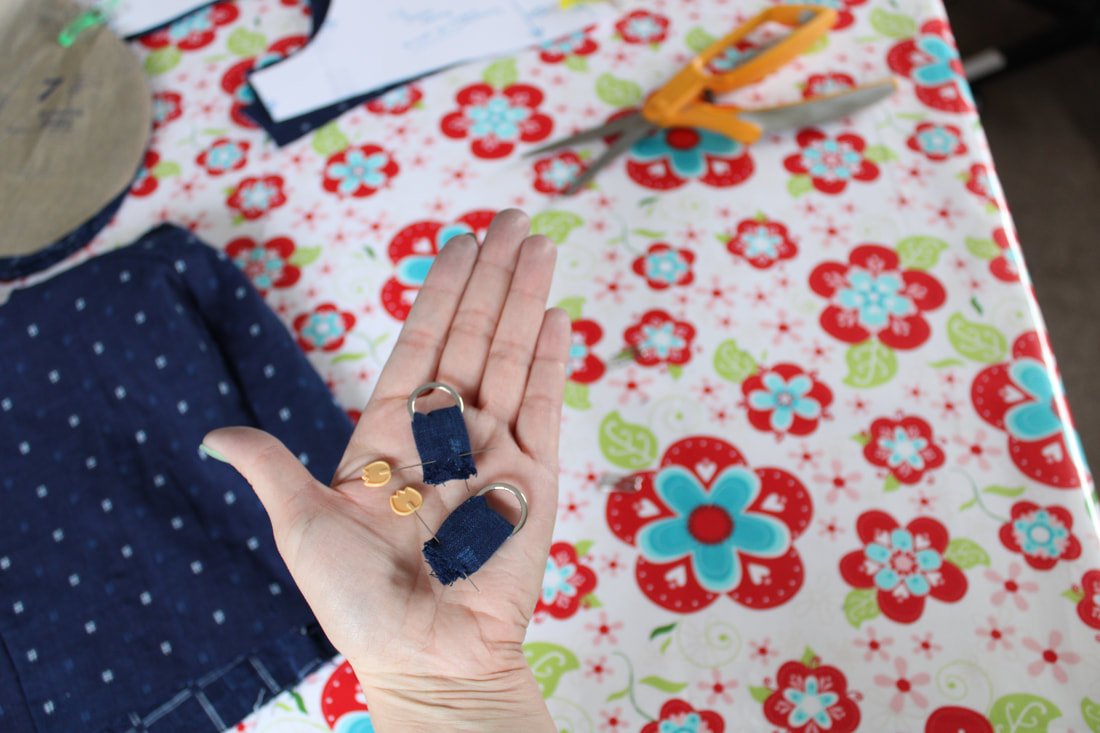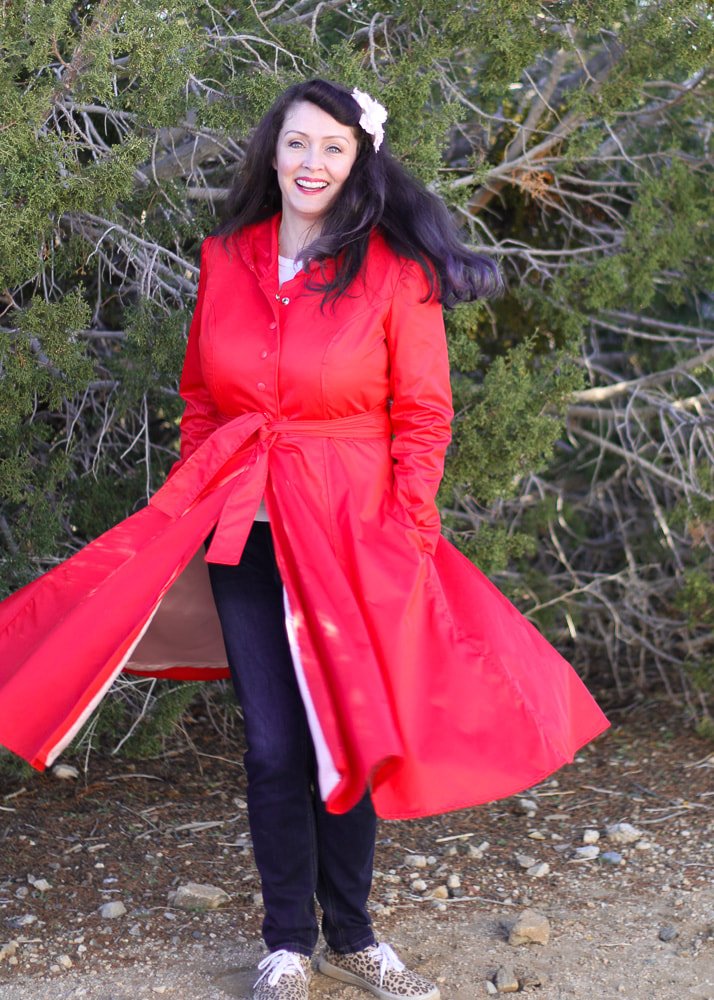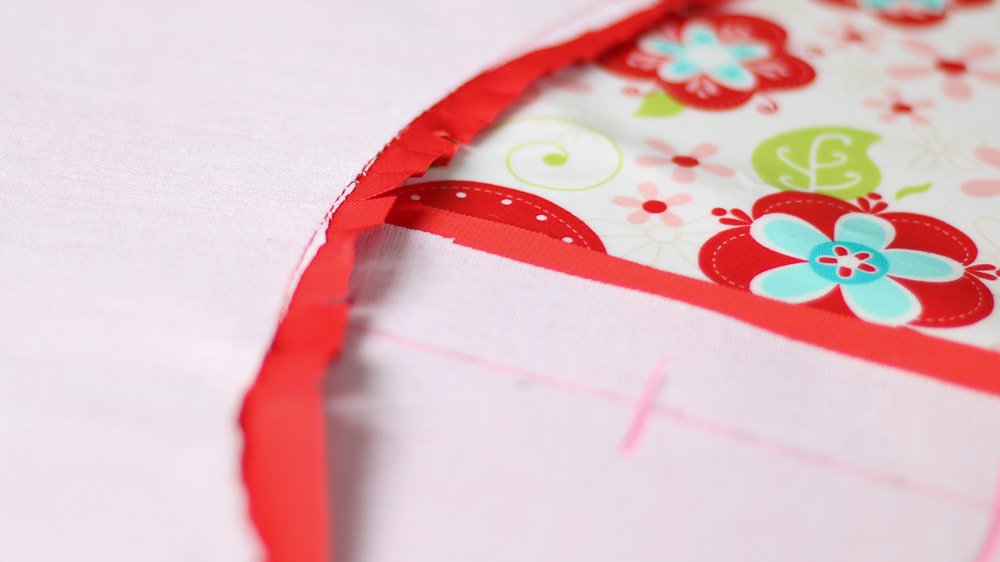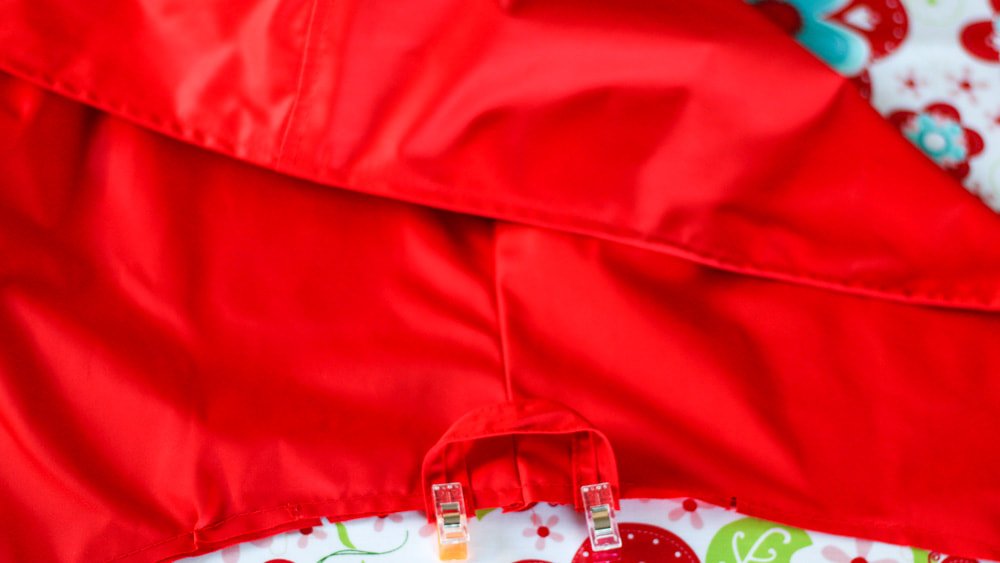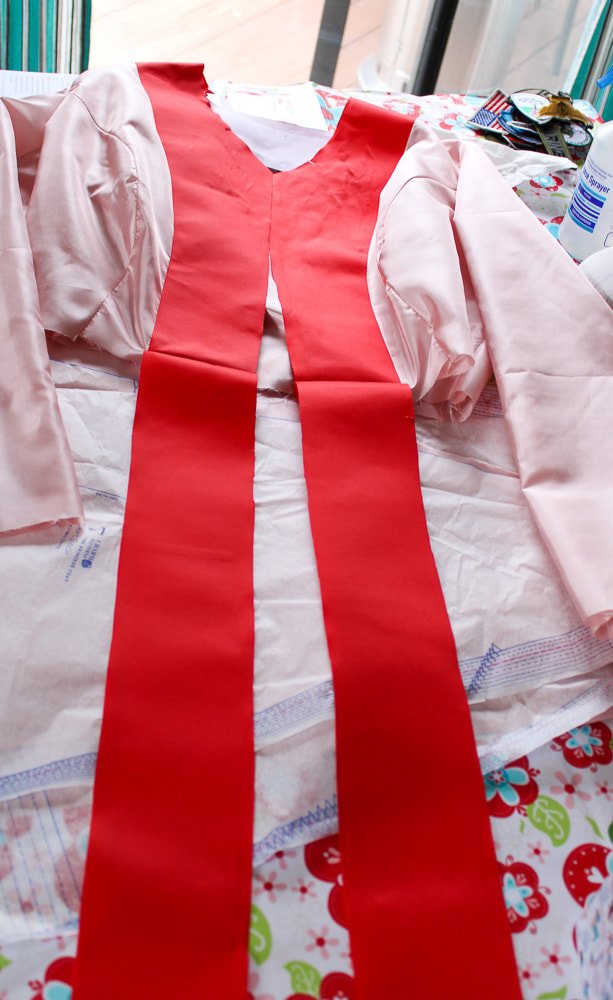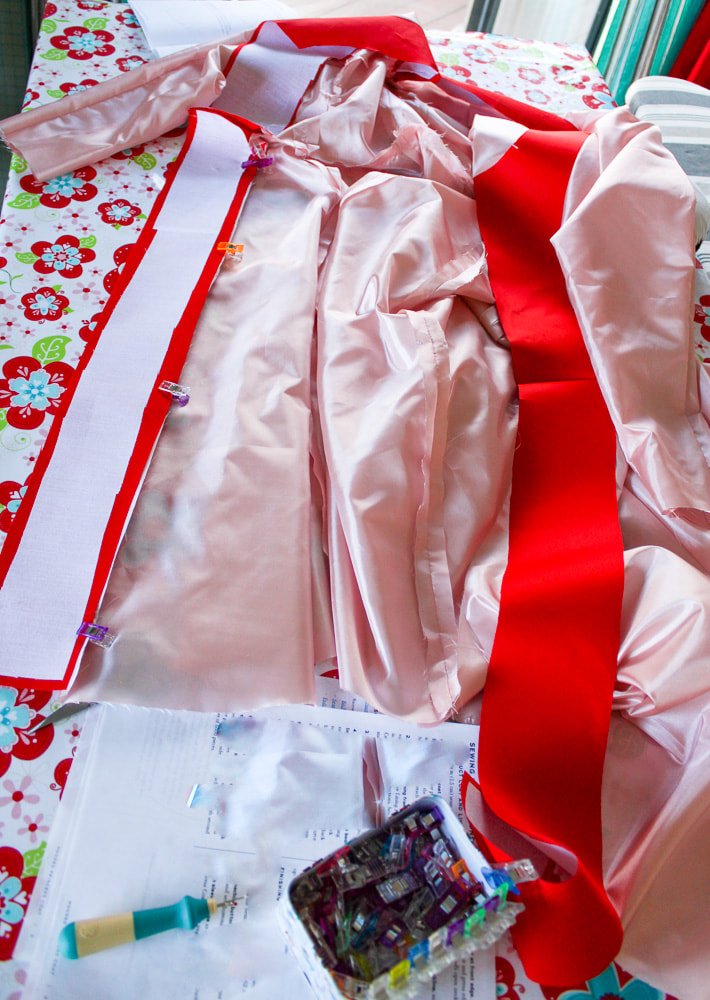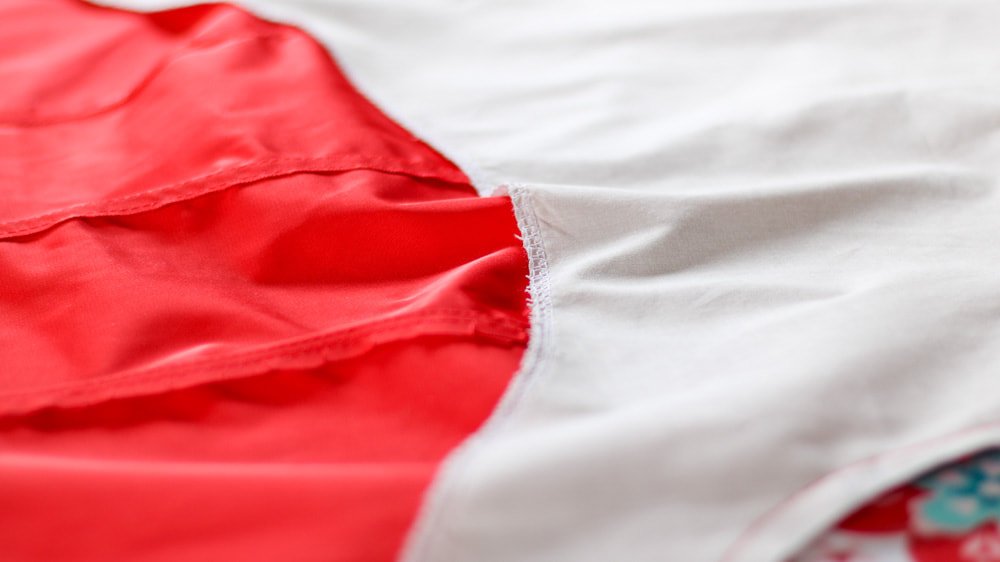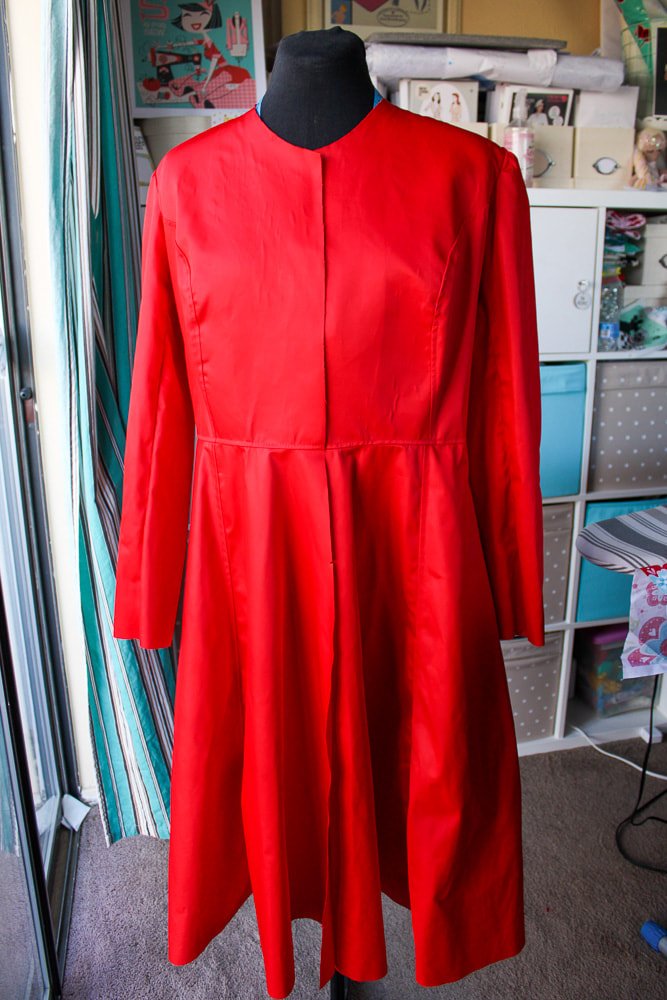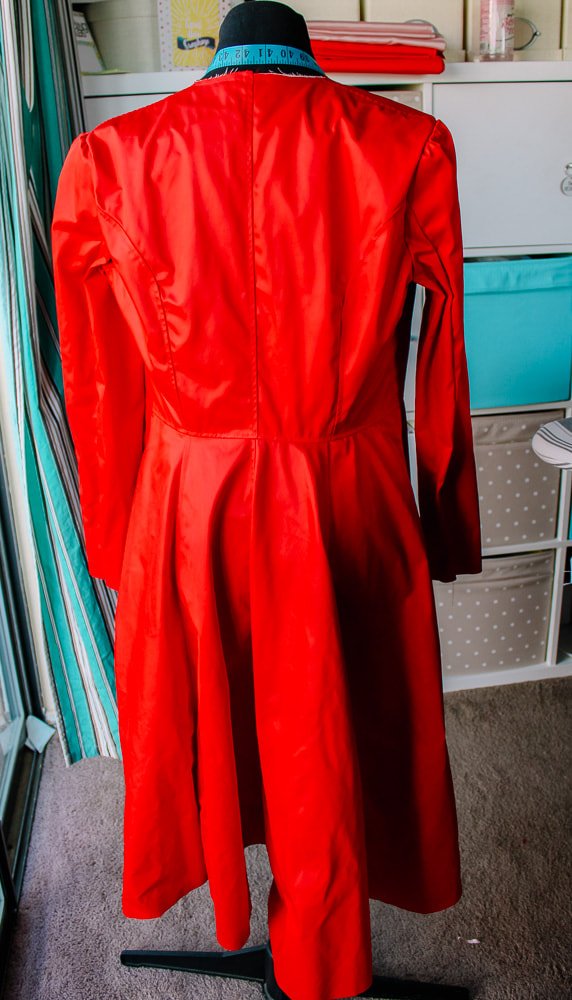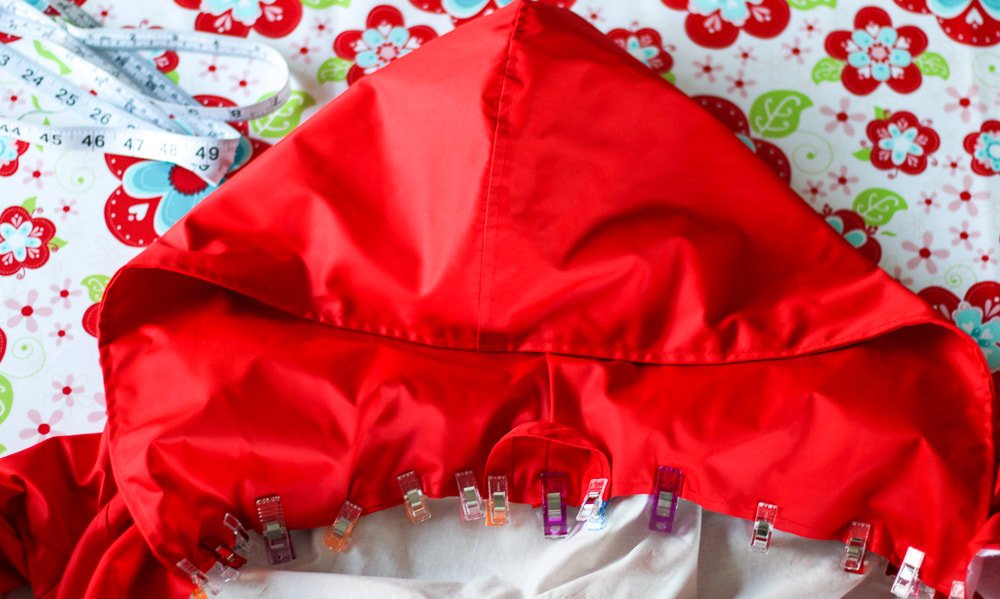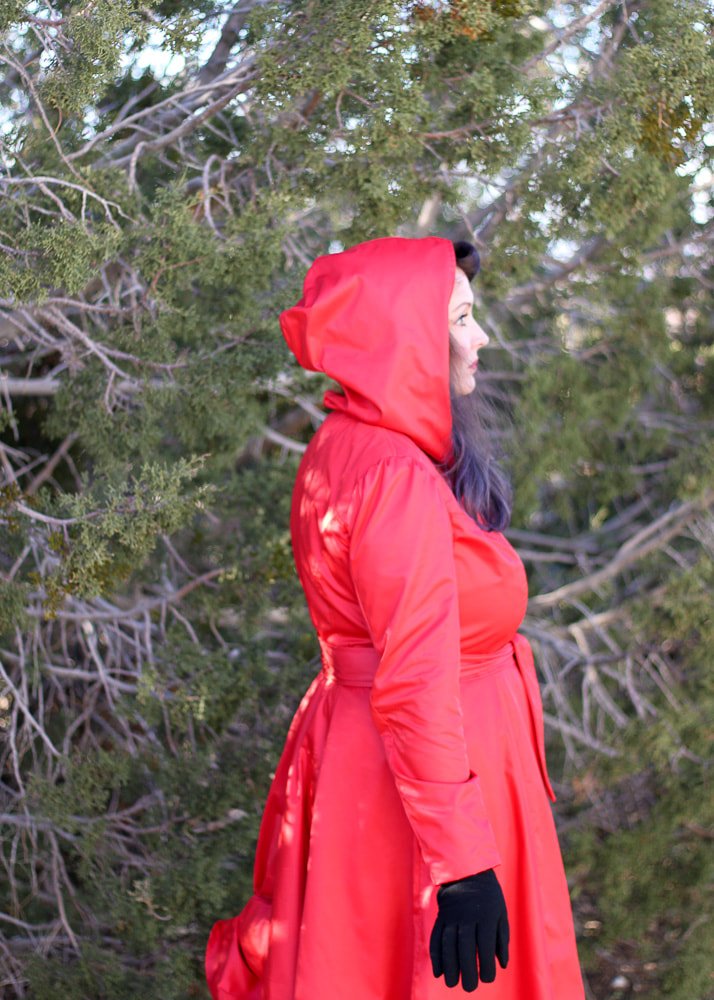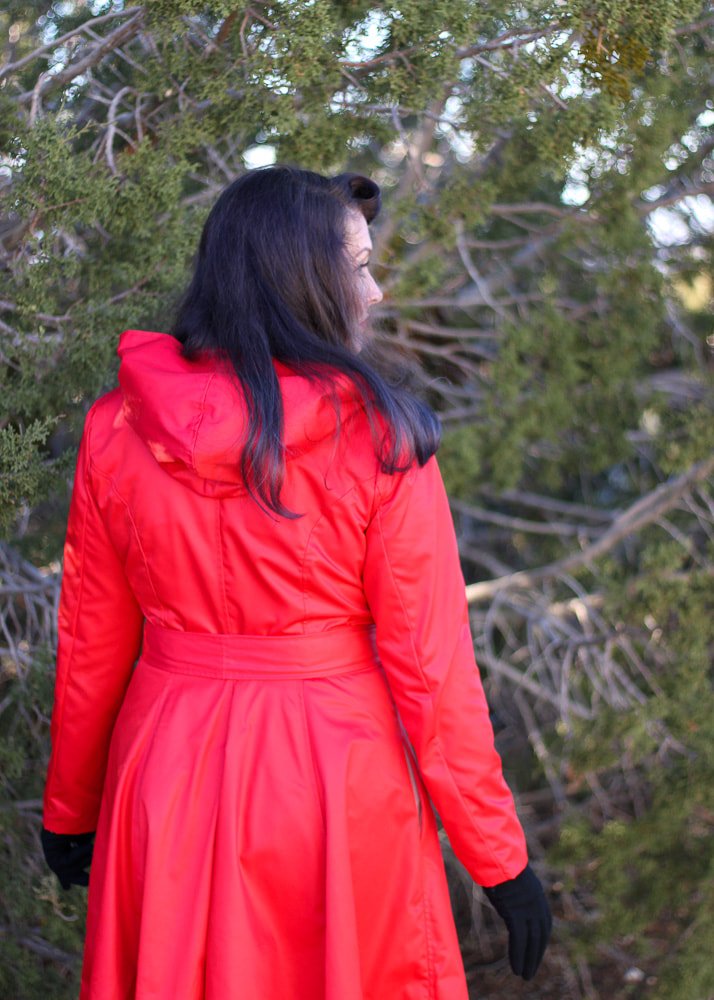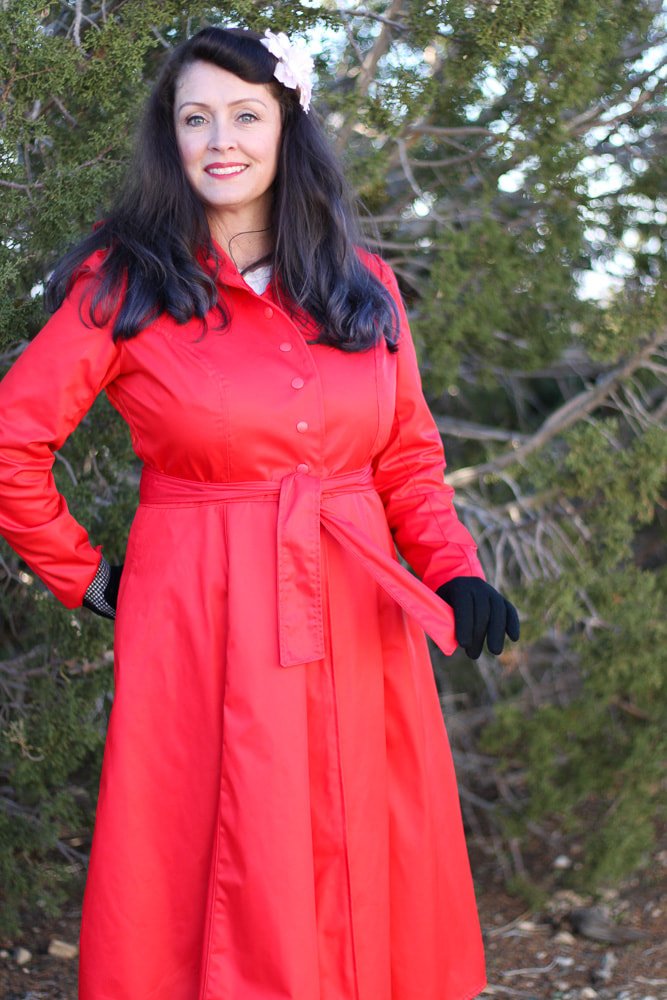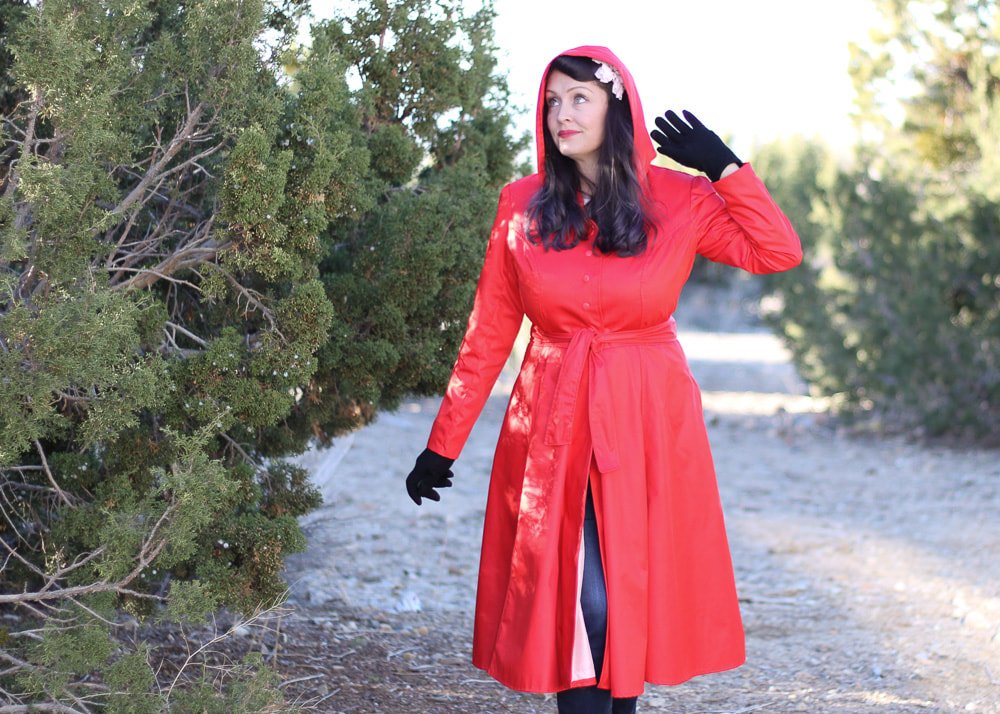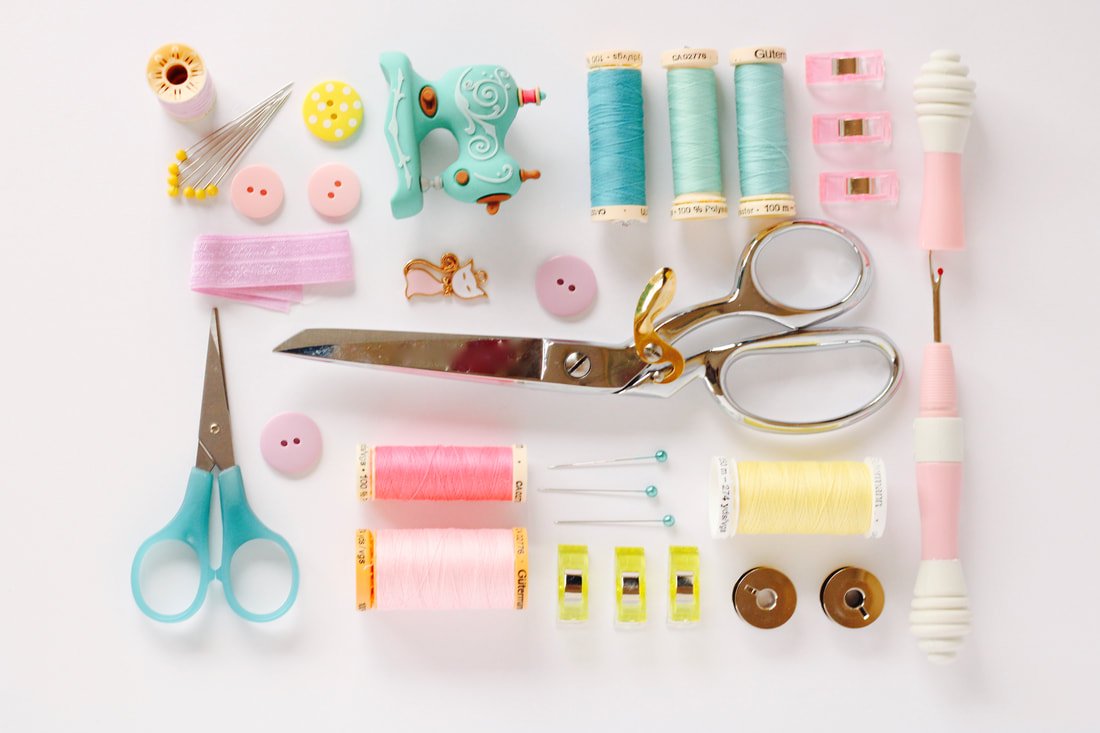
Pattern Reviews, Sewing Hacks, Tips & Free Patterns
Sewing Blog Besties
The Patio Dress by Gertie
Oh Hi! I’m just dancing in my new dress.
As sewists, we often see things out in the world and say to ourselves, (or out loud) “I can make that”! And, then we go home and usually do. Whether it takes a year or five is not the point. Ha! Rewind to last year when I went to Viva Las Vegas and saw beautiful vintage patio dresses. They were all priced waaay out of my budget, so I said to my husband, “I can make one. And, it’ll actually fit”. Vintage sizes aren’t always accommodating to me.
I already had the pattern. All I needed was the fabric. Oh, and trim. Lots and lots of trim!
I was gifted the absolute perfect fabric for a patio dress, so let’s dive in.
I wrote down a sketch of how much fabric I would need. It reminds me of a tiered wedding cake.
I was contacted by Fabric Wholesale Direct for a collaboration. I picked out the fabric, and they sent it to me in exchange for a blog post. That’s a win-win in my book!
I immediately thought of sewing the patio dress because it was fresh in my mind. I asked for 5 yards of shirting in a coral color. I’ve seen a few people make the dress out of heavier fabrics and I knew I wanted something very lightweight. Shirting was the perfect choice! The color is gorgeous too! Exactly what I wanted.
Let’s get to sewing a patio dress.
Gather your tracing tools. Rulers, markers, a pencil, and your favorite paper. I used medical paper this time.
I originally wanted to go with a Western theme, fringe everywhere, and then decided I wanted Ric Rac instead. So, make sure you choose the direction you want for your dress before you go trim shopping. I’ll use the fringe for something else, I’m sure. Eventually.
What You’ll Need
At least 4.5 yards of fabric, I cut a size 12, short sleeve version, and had leftover fabric.
Gertie Sews Jiffy Dresses book, by Gertie
Matching thread
22” ish zipper. I say “ish” because I used a shorter one I had on hand and it worked just fine.
Trim. Yards and yards of trim. I used 20.
Sewing machine
Serger. Not necessary, but it is nice if you have one.
The usual sewing notions
Interfacing
Tools for tracing off your pattern: paper, pencils, ruler, weights, etc.
A ruffler foot. This is reeaaally nice to have.
The Bodice
Start by washing your fabric. This is always step one.
Trace your pattern from pattern page 5 in the book envelope. I used medical paper, fun markers, and a ruler to trace the straight lines.
Cut out your new pattern pieces. I use a small rotary cutter for this. I never used it for anything else, so it’s my pattern paper cutter.
Transfer all markings to your fabric. Then, cut out your fabric.
I like to apply the interfacing now, to get it done and over with.
Serge the vertical edges if you’d like. The shirting fabric I used wasn’t too bad at fraying, but the serger keeps the edges nice and clean.
Stay stitch your neckline, both front and back. This is an important step, especially for this lightweight fabric. You don’t want to stretch out the neckline while you're sewing rows and rows of trim.
Gather your trim. Originally I thought I could start sewing the dress first and worry about trim later. Nope, that’s not the case. The trim goes on the bodice in step number one.
I rummaged through bags of what I had on hand and started with those colors. I liked how they looked with the coral fabric, so I stuck with a fun color palette. It was deemed my Candyland dress.
I was surprised that I didn’t need to add interfacing to the back of the fabric considering the amount of Ric Rac I added. But, this fabric held up just fine.
Place the trim along the lines. I snipped into my seam allowance to mark those spots.
Play with your different trims. Use ribbon, pom poms, and/or ric rac. Move them around to decide on the layout you love.
Pin everything in place and sew.
Go slowly, pulling out your pins one by one. I just eyeballed the seam line and kept it in the middle as best as I could.
Repeat on the other side. If you transferred your markings correctly, they should meet up in the center perfectly. Mine met up, but the nature of ric rac looked wonky. I decided I didn’t mind and kept it as-is.
Ta-da!
Sew your darts in the bodice pieces before you sew the center front seam.
Now it’s time for the collar.
The collar was easy enough, thankfully.
Below is a 1,2,3 of which direction the sew the collar and facing together.
Start at the top out edge, sew along the top to the corner, then down. Clip corners and turn out.
After that, you’re going to sew the collar to the bodice neck, at the back.
So far, so good. We’re moving right along.
Overlap the back collar. Mine didn’t really overlap, but I made it work.
Sew the neck facing.
This is easy-peasy. Pin in place and sew.
The collar should look like this. Sorry for the blurry photo, womp-womp.
Next, sew the side seams and back seam down to the marked area. The zipper will go here, eventually.
Start stitching from the waistline and go up to the arm opening.
Sew the short ends of the sleeve facings.
I chose to make the short-sleeved version of The Patio Dress. Sew the short ends together, and press open.
The long-sleeved version will be different.
The sleeve facing didn’t line up perfectly with the sleeve opening. I don’t know if I did something wrong, or if the pattern was wrong.
I marked where the correct seam needed to be and sewed a new seam.
It matched up perfectly. Yay!
The Skirt
Buckle your seatbelts, this part is a doozy.
In her book, she guides you on how to measure the skirt tiers. I followed what Gertie did.
Measure your waist. Write it down. Double it. This will be your first tier.
Then, double that measurement to create your second tier.
Then, double that for your third tier.
Easy enough, right?
Okay, she does some math to get the height of the tier, in the end, she makes them 10” tall. I did exactly that.
For example: The top tier will measure 60” long by 10” tall, for a 30” waist. Then, the second tier will measure 120” long by 10” tall, and so on.
I folded my fabric in half, selvage to selvage.
Measured 10” from the bottom edge and marked it. I ended up cutting 9 strips. My fabric was 56” wide. So keep in mind how wide your fabric is.
I serged the short edges together to form one super duper long strip for gathering.
My advice for this next part? Put on headphones and play a podcast or fun music. This is going to take a while.
The ruffler foot. It looks scary, but it’s easy to use once you get the hang of it.
To make sure the ruffler foot works out for this pattern, Gertie has you grab a piece of fabric that measures 10” long. Insert the ruffler foot, and change the settings until it gathers the fabric to 5” long. Basically, half the amount.
My foot was set on 6.
Now it’s peanut butter, ruffle time! If you don’t get the reference, sorry. Random songs live rent free in my head.
Afterwards, you’ll have a huge pile of ruffles.
Whew! It takes a minute, doesn’t it?
Grab an end and start measuring. You want the first tier to be the length of your waist. Measure, then snip into the mark and rip the fabric to get an even edge. Or, just cut through.
Next, you’re going to pin and sew the top tier to the bodice.
Pin those riffles in place from one back bodice opening to the next. Sew.
Oooh, it’s looking like a peplum shirt now. Yuck!
Next, you’ll add the second tier. Pin to the top tier raw edge, then sew. And repeat with the last tier.
Time to Trim the Dress
Gather your trims and start pinning at the seamline. Gertie said to start above the seam, but, I liked covering it up a little. Choose your own adventure here.
Pin all the rows at once and then sew. Or, pin each row and sew. It’s completely upto you.
Pinned ric rac before sewing.
A little word of advice: Pin the trims on and try on the dress. I found that I didn’t like the blue because it clashed with my teal trim on the bodice.
Time to bust out the seam ripper. Boooo!!
I turned on a show and ripped out all the blue. Face-palm. Wasn’t a fan of the shade.
And, the green looks much better.
Overlapped rick rack with a drop or two of Fray check.
If you use packages of trim, you’ll need to overlap it. Line up the edges as well as you can and use Fray check to keep it from unraveling.
Next up is the zipper. The pattern calls for a 22” zipper, but I only had an 18” on hand. I made it work. You’ll sew a lapped zipper.
The zipper is in the middle of the back seam. I don’t think I’ve done this before, it was fun doing something new. It was easy too.
You’re almost finished. The hem is next! Yay!!
Make a narrow hem.
I serged the raw edge, then turned it under, and under again to create a nice narrow hem. Use your iron to steam it into position. Pin and sew.
And, you’re done! Throw some flowers in your hair and dance the night (or day) away.
Back of the fun dress. It’s a little baggy and long in the torso. Ah well.
Thoughts:
I thought this dress would be difficult to make but, it was pretty easy.
It was somewhat of a fabric hog, but not as bad as I anticipated. I used about 4.25 yards of fabric. If I were to sew the long-sleeved version, I would have used the full 5 yards.
The fabric really understood the assignment! I didn’t have a single issue. With all the weight of the ric rac, the fabric held up. And, it’s the perfect weight for the many tiers. I would use this fabric again. Oh, and wearing it is comfy too. It feels like a nightgown. The fabric is a little see-through, but I wore skin-colored underthings. No issues.
I didn’t make a muslin because it has kimono sleeves. They usually seem to be more forgiving for the larger bust gals like me.
I would have made a smaller size. the 12 fits, but it’s a little baggy as you can see in the photos. Size 10 for me, for next time.
I wish it had pockets! I assume they could be easily added.
I should have done a short waist adjustment. Whoops! I do them for everything, usually. But, the pattern either didn’t have it marked or I was abducted by aliens during the pattern tracing part.
That’s it. I hope you liked following along. I sure enjoyed making it. If I were to count how many hours it took from start to finish, I’d say around 18 hours.
What do you think? Is there a Patio Dress in your near future? I’m packing it for Viva 2025 for sure!
Happy sewing,
Annette
Wearing my Patio dress by Gertie.
All photos taken by Annette Marie Photography. aka me ;)
Simplicity 8654 Vintage-Style Shorts
Sew the cutest pair of vintage style shorts with Simplicity pattern 8654. It’s a great pattern with an authentic vintage feel and fit. Uses a lapped zipper, one button, and has a pocket.
Summer is here, and do you know what that means? It's time to tackle your warm-weather vintage sewing patterns. The weather has been cooler lately, but shorts are still a necessity. The Simplicity vintage-style pattern 8654 is a perfect summer sewing pattern. It has swooshy shorts, a cute top, and a fun skirt. I chose to sew the shorts. I have a pair of RTW shorts that are similar, but no longer fit. So, I decided to make my own. The shorts have minimal pattern pieces (4) and take about 2 yards of fabric, more or less depending on your size. Let's get started!
Cut + Trace
Find your size on the pattern. The style is very forgiving in the hips, so I went with my waist measurement only.
Cut the pattern or trace it onto paper. Transfer all your markings. This is especially important for the pleats.
Cut out the fabric pieces and interface your waistband.
Sew, sew, sew!
Match the front pieces together. Pin and sew along the curve.
Sew the inseam curve.
Fold the pleats, matching the marked lines, and sew. Do this with both of the front pieces. Then, repeat the same steps for the back pieces. The pattern instructions were fairly easy for these shorts. No issues to write home (or you) about.
Mark and sew your pleats. The marking is the most important part.
Topstitch the pleats in place.
Your pleats should look like the ones above. Topstitch after you sew them to keep them secure.
Flip over the shorts, and there will be two rows of stitching, like the photo below. So far, pretty easy, right?
After top stitching, you will have 2 rows of stitching. the inside will look like this.
Grab your two pocket pieces. Sew along the edges on a front piece and again on a back piece. This pattern only has one pocket because of the side zipper. If you're feeling brave, you could easily add a second side pocket and insert the zipper in the back seam instead.
Sewing is all about customization. :D
I didn't love how they had you sew the pocket. But, note to self, next time sew it up how I would regularly sew an inseam pocket.
Zipper time! This pattern calls for a lapped zipper, which is a true vintage-style zipper. I am somewhat new to the lapped zipper, as I've only been sewing them for 2 or so years. I'm a huge fan! They take minimal effort and go in pretty easily, with a few tips and tricks.
I use a strip of 1" interfacing for all of my zippers. It helps stiffen up the fabric, and the zipper looks nicer after it is sewn in.
Press the right side under 1/2". Pin the fabric right next to the zipper teeth. Sew, using a zipper foot.
Then, press the left side under 5/8". I close the zipper and pin the fabric to the zipper tape. Be sure to barely cover the right side stitches. Unzip, then sew.
Topstitch the lapped zipper. These are so nice to sew and look nice too.
Time for some waistband action. I sewed a straight size 18 for the shorts and used the size 18 waistband pattern piece, but the waistband was too short. So, I added an extra piece of fabric to ensure the waist band was long enough. I've noticed with a lot of patterns that the waistband always falls short of the skirt, shorts, or pants. ?? Maybe I'm broken, but does this happen to you?
It was an easy fix, luckily. Just make a note of it when you make these shorts.
Pin and sew the waistband to the shorts, making sure to match notches and seams.
Had to add extra fabric to the waistband. Nobody will notice.
After sewing the waistband to the shorts, flip the raw edge over to enclose the raw edges of the shorts. The band will enclose them.
Pin from the outside, right along the seam line, catching the inner fold with the pins. This is my most favorite way of sewing a waistband. It goes quickly and has a clean finish.
Fold over edge, pin, then sew.
Time to hem your new shorts. You can turn the raw edge under 1/4" and then under again, as the pattern instructions say. Or, serge the raw edge, and turn under once, and sew. I prefer to do it this way most of the time. It is quick and easy, and is great for pants or shorts.
Hem the shorts. Turn under and under again. I serged the edge.
Add a label in the back of the shorts. The front looks very similar to the back, so this little addition helps when it's time to get dressed. If you don't have labels, add a fun piece of grosgrain ribbon.
Add a cute label.
Don't forget to add your buttonhole and button. I opted for a fun contrasting pink one. I love my colorful coral zipper too. It mostly matches. Ha!
End Thoughts
The shorts fit great! I went down a size in my waist because I know the big 4 patterns usually add a lot of ease. My waist is 33-34", and I sewed the size that had a 32" waist. They fit perfectly and have a little wiggle room. The fabric I used is a rayon challis. In my experience, rayon shrinks over time with the first few washings. If it shrinks, I'm good. If not, I'm good. Either way, I'm happy with the size I chose.
The fabric is a Gertie designed fabric she used to have at Joann stores. It's almost a decade old. I made my first Rita Blouse with it. The leftover fabric was from the yardage I bought all that time ago.
Funny enough, I did not have a top that matched my new shorts. Yes, I have black tops, but I wanted some color. I made a solid bright pink Rita to wear with them. I know, bizarre for me to sew solid fabrics. Because the shorts were so busy, I wanted some simplicity on top.
Next time I make these shorts, I'm going to play with the pleats. I think I'll fold the fabric differently to give them a different look. Maybe a large box pleat?
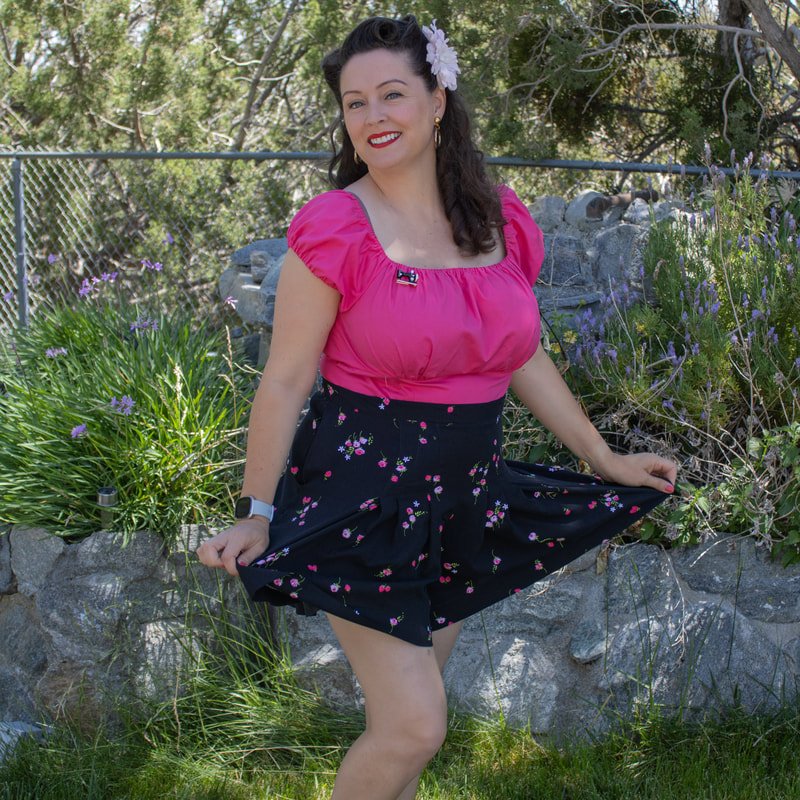
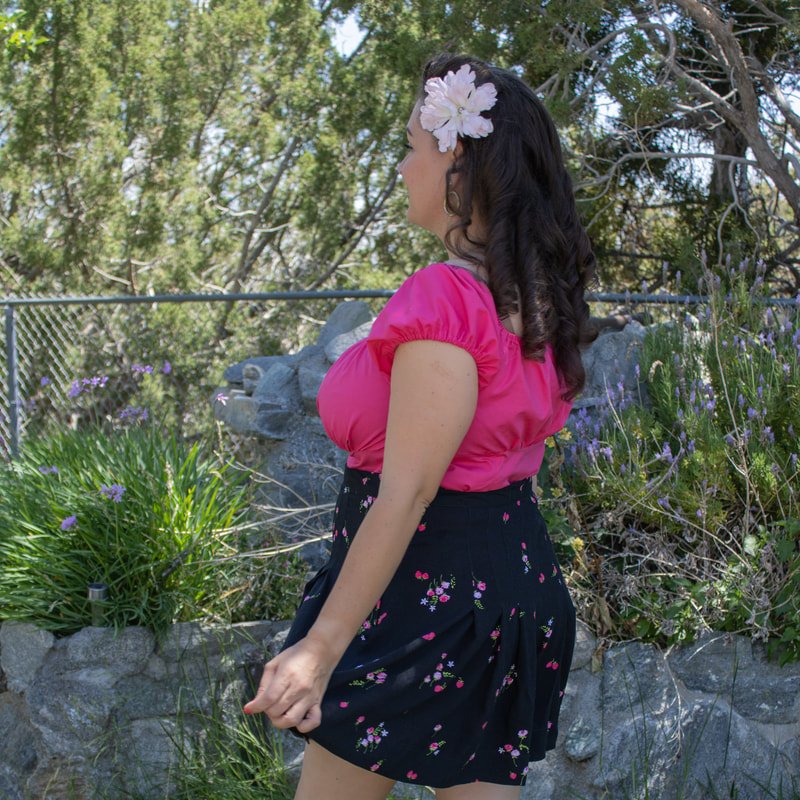
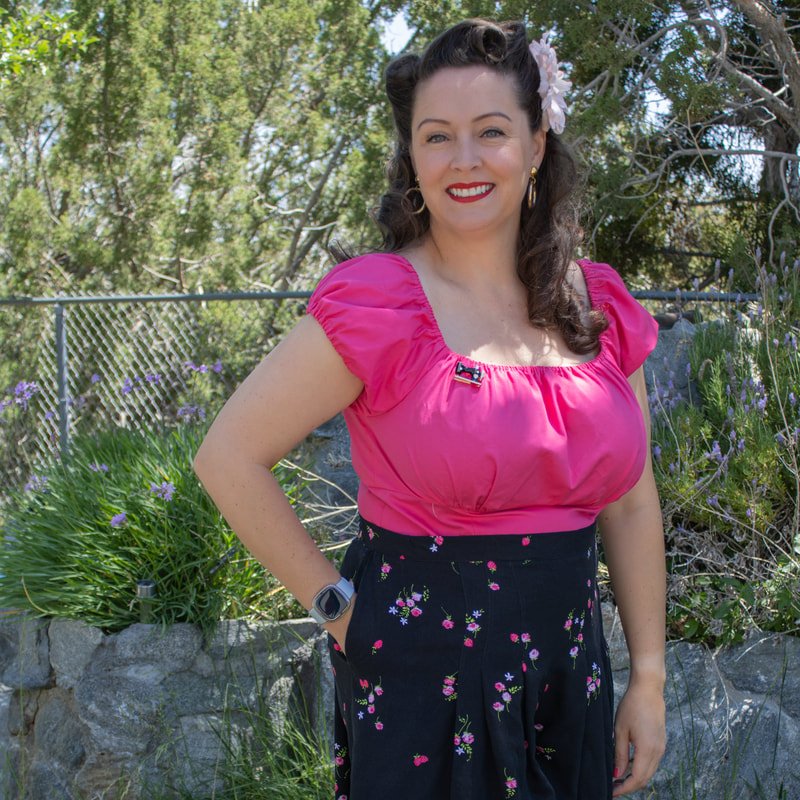
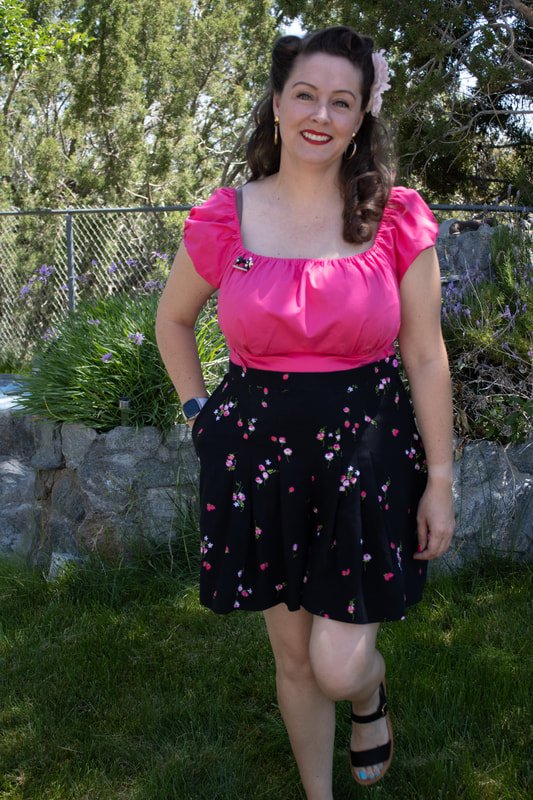
Thanks for following along. Now, go grab the pattern and get started on your summer sewing.
Are you excited to make these shorts? Have you made them before? Would you make them again?
Happy stitching,
Annette
Gardner Top by Gertie
Sew the GArdner top by Gertie at Charm Patterns. It’s one of her Patreon exclusives and it’s a beautiful top. It uses knit fabric, sheer fabric, and a single button. It’s easy and could be for an adventurous beginner. It is casual yet elegant.
The holidays call for fancy fabrics and sequins. Don't you agree? There's just something fun about wearing sparkle during the festive month of December, isn't there? Add soft velvet and, I'm in! If sewing velvet scares you, read this post. I share my sewing machine and tips for tackling tricky fabric.
These Gardner tops fulfilled my fancy holiday fabric needs. The fabric was originally for vintage-style turbans. I've wanted to make velvet ones for quite some time. I only had 1 yard of each and was lucky that the one yard worked out. Whew! I changed direction at some point and decided to make Gardner tops instead. The matching sequin fabric went with the red one, and the sheer floral went with the green one.
As usual, I don't go into depth with Gertie's Patreon patterns because I value her as a creator. However, I like to share tips and photos that show you my process along the way. If you're interested in this pattern, join her Patreon membership. She shares new patterns each month and so much more!
I made one Gardner top following the exact directions and another collar-hacked version. This post is full of photos. Let's go!
Red Gardner Top (Original Pattern Version)
Red Garner Top
Start your top by tracing the darts onto the front. I prefer old-school wax paper and a tracing wheel system for this part.
Staystitch the front and back necklines. Sewing from the shoulder towards the center prevents the neckline from stretching out. Never skip this step.
After you sew up the darts, cut them open. If sewing your top with velvet, don't press the seam open.
Cut dart open.
The sheer fabric is full of glitter, sequins, and all the sparkles. Perfect for holiday festivities.
Yay, no puckers!
If you go slow while sewing and make sure your seams are clipped, you shouldn't get any puckers in the V-shaped front. If you do get puckers, unpick that section and re-sew.
Sew up the back sheer keyhole area. Use thread that blends in with your fabric or skin tone.
Attaching the back sheer piece onto the back bodice went smoothly. It felt easier to sew than the front. But, follow the same process.
Wah-la! I love how the sequin fabric looks with this red velvet. So festive and fun. Don't you agree?
Make sure you top stitch to keep all the layers flattened on the front and back.
The Collar
The collar was easy to sew, but it was tricky with velvet. I used sew-in interfacing that worked nicely. It went in smoothly, but I had a hiccup when I made the green top. You'll see below how I went in another direction with it.
I did a few hand stitches to keep the collar together. All in all, it worked, but I wouldn’t want to sew another velvet collar in the future.
The sleeves and hem were easy to finish. I love this pattern and see many more Gardner Tops in my future.
All that's left is to sew on the hook and eye at the keyhole.
I love the fit. I could have gone down a size, but I didn't want it to be too tight. This was a wearable muslin, and you never know until you make it. I love it despite the semi-itchy sequin fabric. Haha
I wore the red one to ring in the New Year. It had just enough sparkle to make me me feel festive.
Green Velvet Top (Hacked Collar Version)
I didn't intend this Gardner top to be different, but I tried to fuse interfacing strips on the collar, and it didn't work in the end. So, after ripping out the collar, I ended up with a collar band and button. I wanted to show up in case you had a collar issue or just wanted to do a collar band instead.
I traced both tops with my favorite chalk pen by Clover.
Cut both tops with my rotary cutter and mat. This keeps the velvet from stretching out.
Green Velvet Gardner
I only had 1/2 yard of the sheer fabric, so I had to change the direction of the print to fit this top. The front has the vines running horizontally while the back is going vertically. Nobody will notice unless I point it out. I wanted to show you just in case you run into this issue, too. ;)
Collar Band Hack
I shared on Instagram my collar flub but didn't take any photos with my camera. So, instead, you're only seeing the band option.
I measured around the collar opening and cut a strip that same length plus 1" by 3" wide.
I folded the raw short edge under, pinned the long raw edge to the sheer fabric, and sewed with a 1/4" seam allowance.
Fold the other long edge over and under, then pin and stitch on top. Stitch from one end to the next, making sure to close up the folded side. I stuck a small hair elastic in one end, for the button loop.
Hem the sleeves and bottom hem using a zigzag stitch after turning up once.
I picked the sparkliest button I had in my big button jar. I wish it was gold but, it works well enough.
What do you think? Do you like the original collar version or the hacked band version better?
I can't decide if I love the sparkles and red velvet or the florals and green velvet better. They're both so beautiful and fun!
Don't you just love this top? My favorite part is how the sheer sits on the shoulder. It's flawless and so feminine. It's also fancy and comfy to wear. I love how quickly the band came together, where as the collar took a little more time. But, I do love both versions.
Thanks for hanging with me today. Go join her Pattern and get this beautiful pattern along with tons of others.
Happy sewing and happier pattern hacking,
Annette
Butterick B6453: The Easiest Dress to Sew
Butterick B6453 dress sewing pattern. Beginner-friendly vintage style dress. Sew an easy dress with lots of vintage style.
If you need a break from difficult sewing projects, I encourage you to grab the Butterick 6453 dress pattern. It was easy and fun to sew! The only timely adjustment I needed to make was an FBA. After that was sorted out, it was all downhill.
This dress is fluffy and full, no need for a crinoline underneath. The princess seams are flattering. The straps are perfectly positioned. And, the back zip is a cinch. What are you waiting for? Grab the pattern and let's get started!
Supply List
A whole lotta fabric, this dress is a fabric hog. 4-5 yards is needed
Interfacing
Matching or contrasting thread
Sewing machine and notions
Serger, pinking shears, or a zigzag machine to finish the raw edges
16" or longer zipper
Seam ripper because... sewing
Rings and sliders for adjustable straps
Sewing Notes
This dress is super easy and only has 10 pattern pieces! This was wonderful news because I made the Hooded Princess Coat before this dress and that was a beast. Read the post if you've always wanted to make your own raincoat. Gertie did a wonderful job with the pattern.
I chose double-faced linen. It was a little heavy for this exact dress but, I love it nonetheless. It'll be warm enough to wear in the fall paired with tights and a sweater. I suggest using regular linen, cotton, gingham, etc. Check the pattern envelope for fabric options.
Shorten or lengthen to fit your torso. I shortened the bodice pieces by 1.5" because I have a short torso. I could have gone a little shorter.
Size down 1-2 sizes at least. I sized down but, in the end, the dress was still too big. Four inches on each side, too big! I have to take in everything. Ugh. Honestly, I threw on a little belt and it was fine to wear. But, I plan on taking in the side seams, princess seams, waist, etc. Cue the tears.
Widen the straps if you wear larger bras. Us gals with bigger cup sizes know the wide bra strap game all too well. I made my dress straps 1" wide and they cover my bra straps perfectly.
Trace and cut out all your pattern pieces. Make sure to transfer the markings and notches. I didn't trace the pocket or skirt pieces onto new paper. Sometimes I get lazy and use the actual pattern tissue. Please don't tell the sewing Gods on me.
Staystitch your neckline, don't skip this step.
Sew the darts.
Then, sew the princess seams to the front bodice piece. I find it easiest to clip the front piece a little to help with the curve if needed. Also, it's easier to sew with the flat piece on the bottom. Go slow and adjust as needed; you'll have a pucker-free seam in the first go.
After the princess seams are sewn, match the side seams with the back pieces. Sew from the waist up.
Here's a Tip:
If you have an old bra lying around that no longer fits, cut it up. Use the metal hardware for your dress straps. I save all my metal hardware from old bras.
Notice my blue fingers? I've washed this linen three times and it still makes my skin blue. Ack!
Pin your straps into place and try the bodice on before stitching the straps on. I waited until the dress was fully sewn before I did this. The linen weighs a ton and I knew the skirt would pull it down. Yay, gravity! My fabric was too thick to make adjustable straps so I ended up sewing the strap ends onto the bodice. But, I love adjustable straps, even though the dress will only get worn by me. :)
Here's a bra hack post if you're interested in DIYing your bra.
Gather and sew the skirt's front and back pieces together. I didn't take any photos of this because it's pretty easy.
Zippity doo-dah! This pattern calls for a lapped zipper. I'm still on the fence about whether I like doing lapped zippers or not.
Press the right side under 1/2" and press the left (lapped) side 5/8" under.
Pin the right side and sew down from the top, using a zipper foot. Go slow to avoid any mother puckers. ;)
Pin the left side starting at the waistband. You want that area to match up. Then, pin upwards and downwards making sure the raw edge will be hidden after it’s sewn. Go slowly starting from the top and sew down. Swivel and sew a few stitches across to seal the end of the zipper.
Ta-da! Your zipper is complete. A white one was used because that's all I had on hand. I was doing a "no buy" sewing challenge. I normally would have used a navy blue one but, the white still matches. Sorta. Ha!
I eventually lost the challenge after a fabric cutting mistake though. Insert eye roll.
Butterick 6453
All that's left to do is sew the hem. Choose an easy hem, turn up the raw edge 2", and then turn it up again.
So, that's it. This is the easiest dress pattern I've ever come across. Are you going to make one? Do you know of an even easier vintage-style dress pattern? Heck, my caftan was more involved than this was. I assumed a caftan would be easy. Nay-nay!
Thanks for hanging out today. If you are looking for a few other pattern reviews, click here for the Ginger Jeans review. Or, here for a Cheongsam sew-a-long.
Happy sewing!
Annette
Hooded Princess Coat by Charm Patterns
Gertie’s hooded princess coat sewing pattern review and tips. I love the pattern and it sews together beautifully. With rain resistant fabric and the added hood expansion, it makes the cutest vintage style raincoat. It’s a little red raincoat. Not beginner friendly, but a seasoned sewist won’t have any problem making one.
My Little Red Raincoat
This coat is a Patreon expansion pack of Gertie's Princess Coat sewing pattern. Sew your own raincoat to keep yourself dry and cute. It starts with the Princess coat, then you add the expansion pack for the hood.
Do you ever find yourself needing a garment, but you can't find one out there that suits your style? This is that garment. I have a few hooded coats but, they're wool or fleece. Not really a raincoat per se. And, I have two garment obsessions: coats and shoes. I need all the coats and I need all the shoes. Ha!
I think coats and jackets are the best accessories because they add warmth- especially if you're always cold. And, they add fabulousness to your outfit. Imagine yourself wearing a T-shirt, jeans, flats, and red lipstick. A normal little everyday outfit, right? Then, add a black velvet coat and your outfit gets a major upgrade!
That's what coats and jackets do for me. I guess they're my jewelry. So, when Gertie came out with her Princess Coat pattern, I had to grab it. A month later she rolled out her Patreon expansion pack to make a raincoat. I was sold! I needed a raincoat.
Fast forward 2 years and I still hadn't made my beloved raincoat. First of all, rainwear fabric was something I had zero clue about. And, second, I sew on a budget. I didn't have hundreds of dollars to drop on fabric for a coat I would wear maybe twice a year. Thanks, Southern California for never raining. Living in the desert, we don't get a lot of rain but, when it rains, it pours. Hello, flash floods. And, hello Little Red Raincoat.
“It never rains in Southern California”
Tracing and cutting the outer fabric. The kitchen table was the best place for this. It’s a lot of yardage.
This post isn't a How-to because it's an expansion pattern for Patreon only. Gertie is gracious enough to spoil her Patrons with all her marvelous patterns. If you're interested in making a vintage-style raincoat, Grab the pattern here. Then, join her Patreon here. It's definitely worth it. We get a new pattern each month and honestly, it's too many for me to keep up with. But, I choose which patterns are "need to sew now" and which are in the "someday" category.
Anywho, I did have a few little areas I ran into trouble with so, I'll share my input on those. But, other than that, enjoy all the photos of my Little Red Raincoat. Yes, I named it. :D
No rain, but it was a frigid February day.
Why did I start sewing the raincoat after 2 years you ask? Well, remember this post on January Jeans? My sewing friend on Instagram was still talking with her jeans sewing group. They decided to do a #JacketJanuary. I was invited and thank goodness for those ladies! They welcomed me and I made new sewing friends. Yay!!
One gal finished her jacket on time and a few were waiting for the last touches by the end of January. We met every Monday for a fun Zoom call. the group kept me going and I was finally able to get my coat finished. It wasn't finished on time because I was undecided on whether to use buttons or snaps. In the end, I decided on snaps. Buttonholes and water don't go together so nicely
Snaps are usually easy but not this time. I put the first one in upside down. Cried (not really but, I wanted to). Then, put another one in wrong. Ha! I don't like snaps (anymore) or buttons. Face-Palm!
Isn’t my pink lining fun? My coat can double as a Valentines Day coat/outfit.
Let’s Talk Fabric
One of the ladies in the sewing group told me about trench coat fabric. We had a quick chat about that and I had an a-ha moment. It was mind-blowing, believe me. I ended up buying trench coat fabric and it was wallet friendly too. I found some beautiful red polyester twill from Mood Fabrics. They shipped quickly too. According to my measurements, I needed 8 yards. Well, technically I needed 7.5 but, when you order online, you can only order in whole amounts. Fun story, I ended up with almost 4 yards left over. So, now I have no clue what to do with all that leftover rain-resistant fabric. Ugh! I think camping table clothes and bench covers?
The fabric itself is nice. It was a dream to sew with but, it wrinkles very easily. When I'm running through a hurricane looking fabulous, I probably won't mind my wrinkled mess of a raincoat, though.
The lining is poly china silk I bought online from Wholesale Fabric Direct. It's a blush pink color and I ordered 8 yards of that as well because... well measuring. I have tons left over, over 4 yards. The leftover lining fabric didn't bother me because I can use it to line wool pants or anything else in the future. Plus, it only costs $2 a yard. LOL! No tears were shed over that. The rainwear fabric was a different story though. ;)
Tracing the lining pieces. Again, at the kitchen table.
Notions and Potions
No potions except coffee. Lots of coffee.
The thread and needles I used were simple and nothing fancy.
I bought 3 spools of all-purpose red polyester and 1 spool of all-purpose poly pink thread. I read other people’s comments about how much thread they used for the Princess Coat and I didn't want to run out. Well, I didn't even use a whole spool of the red. Ha! I always use red thread because it's the best color in the whole world, so no worries about that.
I sewed my outer coat with a regular 80/12 universal needle. It sewed through the rain-resistant fabric flawlessly. This fabric held onto the holes it was given so, I was cautious but, in the end, just went for it. Backstitching on every seam was fine, no issues there.
For the lining, I knew better. I used a Microtex needle to sew all the pretty pink seams. When it came to sewing the outer and lining together in a few spots, I used red thread and the universal needle. No issues, no skipped stitches, and no bird nests. Yay for nice, cooperative needles.
I used a tracing wheel and wax paper for the outer and lining pieces and cut everything with scissors. It was nice to open the leaves on my kitchen table and lay out the fabric and pattern pieces. My cutting table in my sewing space was not quite long enough for this project.
Adjustments
After making my muslin, I decided I wanted a little more room in the tailored sleeves. I used a 1/2" seam allowance instead of the recommended 5/8". I graded it up when I got to the armpit area. This kept me from having to make other adjustments in the armscye area.
I measured at a size 8 for the coat but graded down at the side seams, to a size 10 at the waist. I love that Gertie gives us different cup-size pieces. The fit was exceptional. I love sewing for my own body. Talk about body positivity. :D
I also adjusted the length as I cut out the skirt pieces. Instead of shortening the skirt length at the shorten lines, I simply cut the length at size 2. This was probably the incorrect way, but it worked for me. Sometimes I like shortcuts.
I added a hanging loop in the back. Cut a 2" wide by 4" long piece out of the outer fabric. Fold in half RS together and stitch with a 1/4" seam. Turn it inside out and baste it to the hood. A hanging loop for a raincoat is a must, right?
I topstitched all of my outer seams. I sewed the center back seams to the left and the other ones to the right or left, depending on each seam. I thought this would help with the rain seepage as well.
Pretty pink pockets.
Issues I Ran Into
The Instructions were a little wonky in areas which isn't normal for Gertie. She's usually spot on. However, I did run into an issue with pattern piece #15, the skirt front facing. Her video says she skipped the hem facings, fine. But, she still had the front facing on her raincoat and it didn't say in the extension instructions how to add this. The booklet instructions were on page 44 but were different. So, I unpicked some of the waist area and attached it to the bodice lining unit, albeit the wrong way, but I got it done.
I had trouble figuring out how to add the neck facing because I hadn't had enough coffee or something. Below, is how it should look. The collar facing is cut with the outer fabric and sewn to the lining bodice at the back collar. It went on sorta upside down. Like I said, maybe I didn't have enough coffee.
Bodice lining.
Neck facing is clipped and ready to sew.
Neck facing and back bodice lining.
I used muslin for the back and serged the edges.
Hemmer Time
Okay, when it's time to hem, be sure to let your outer and inner hang for 24 hours before you hem them. Fabric cut on the bias is no joke. My outer didn't stretch out but, the lining did need a little trimming and evening up.
After hemming 4,000 yards of fabric and removing approximately 300 wonder clips, your hem will be done. Gertie preferred a narrow hem for the raincoat. The way she does it is nice too. Sew along the raw edge with a 1/4" seam allowance, flip it up and under, and sew again. Super easy. It is also nice for a circle skirt hem, you don't have to worry about any puckers. ;) I hemmed the outer and lining before I put them together. I liked hemming the outer and lining separately. Easy and no stress.
I went back and shortened the lining hem length another 1/2" inch. I didn't want to get caught with my lining hem showing. Could you imagine?! Gasp! If you read this before you make your coat, hem the lining 1" shorter to begin with.
The sleeve hems were easy to do too. I didn't attach them as Gertie recommends. Hand sewing, no thanks, and on rainwear fabric especially. I prefer the bagged-out sleeve hem method. You take the sleeves and pull them inside out, fold over the lining cuff 1/2" or so, match seams up, and then sew. I didn't take photos but, here's a website that shows you how. It is my favorite way to sew sleeve cuffs and if you look at your RTW coats and jackets, they probably did it this way.
The pretty pink lining.
You can see ripples in the bodice in the photo below. The water-resistant fabric didn't take well to interfacing. I decided to leave it but, might rip it out later in life. We'll see.
I top stitched over all the seams in hopes to keep the rain out.
Let it hang for 24 hrs.
Ooh la la, I love my lining.
Final Thoughts
I'm so happy with how my Little Red Raincoat turned out. It was such a fun sewing project. Thank you to the #JacketJanuary sewing group, you ladies rock! I can't wait to sew up a few more jackets and coats using The Princess Coat pattern from Charm Patterns. Gertie, you really outdid yourself with this beautiful pattern, as usual. If a hooded coat scares you, don't let it. The hood was the easiest part. It's a nice roomy size so my vintage-style hairdos will fit inside without getting messed up. Yay for that!
She gives quite a few sleeve choices. I want to make a mustard yellow coat next. I need some fun tweed to make a cropped jacket with a dare I say, faux fur collar! Perhaps some light pink boiled wool with a black fur collar too. Hmm...
I have no clue what to do with almost 4 extra yards of red rainwear fabric. Any ideas? Share them in the comments below, please. I need ideas. LOL
Scroll down to see more photos of my glorious coat without rain.
Thanks for following along with my coat journey. Now, if you could all send some rain my way so I can try it out, that'd be great.
Happy sewing,
Annette












